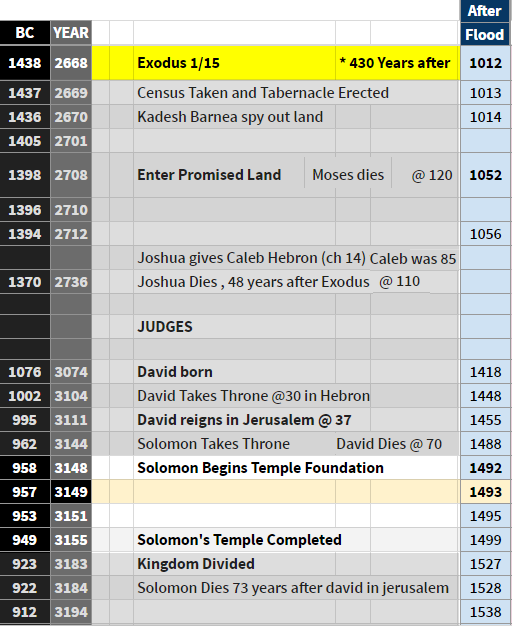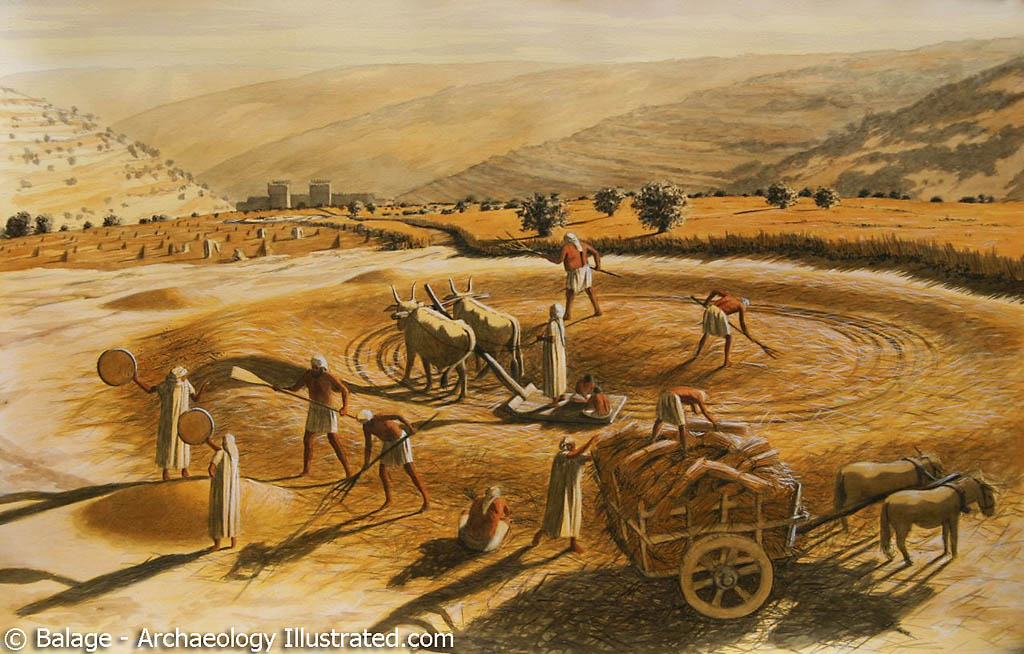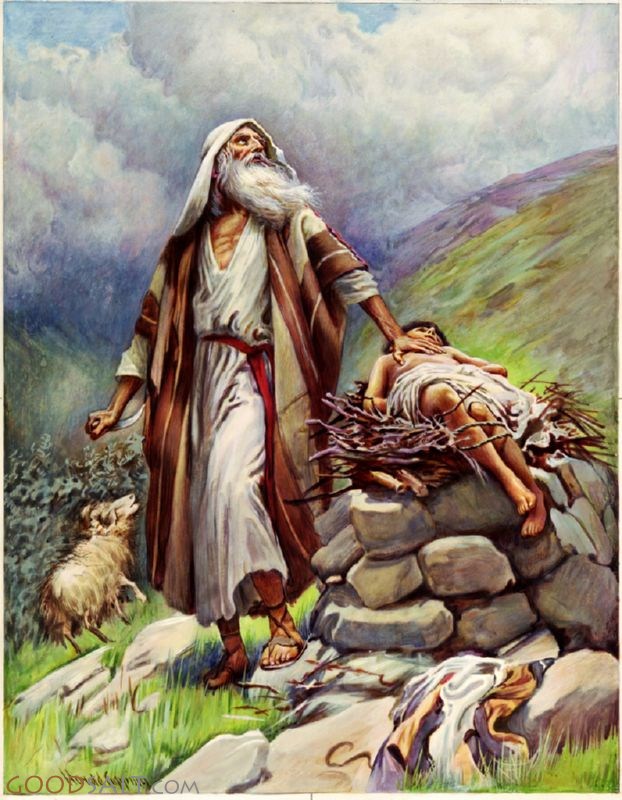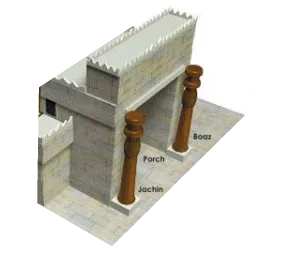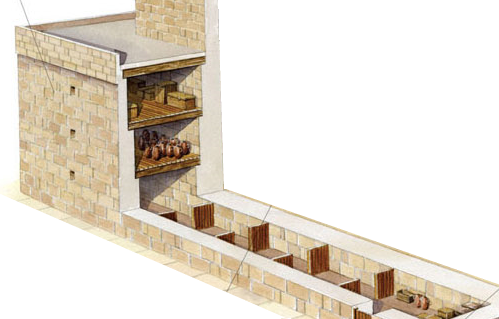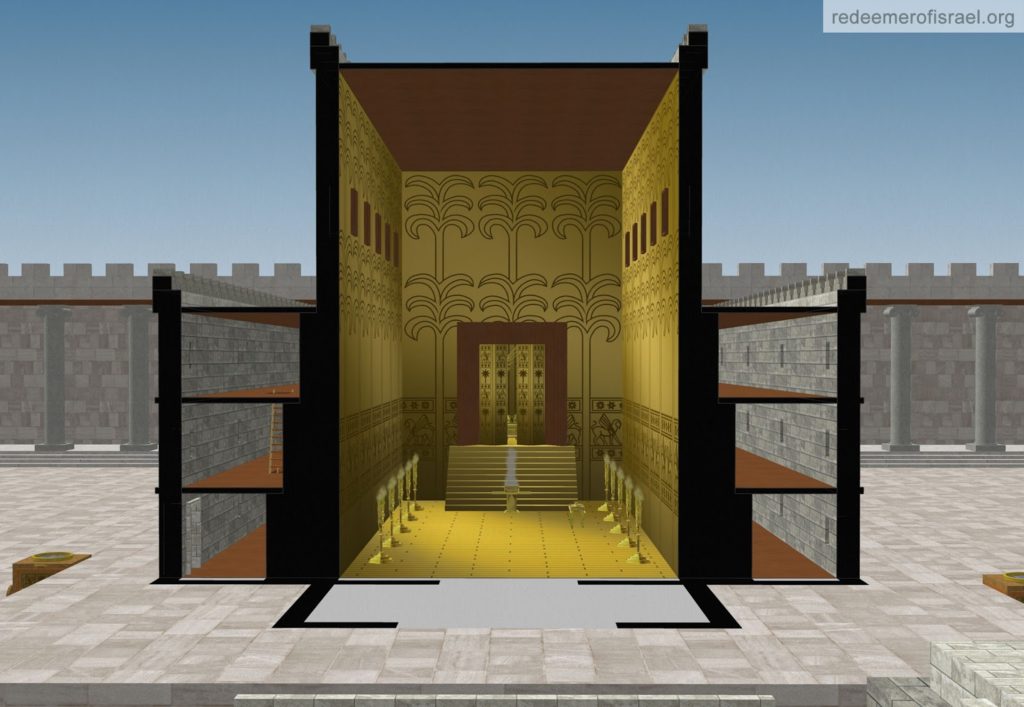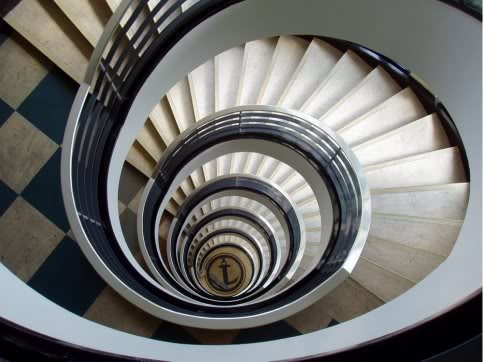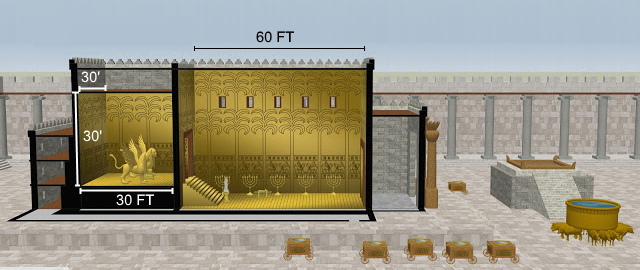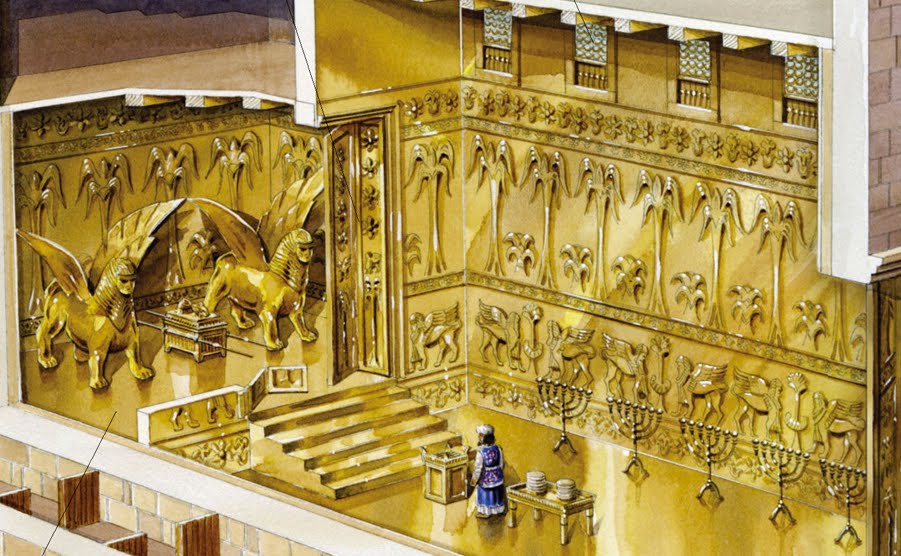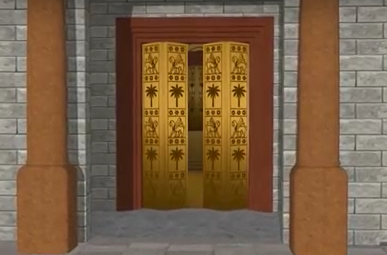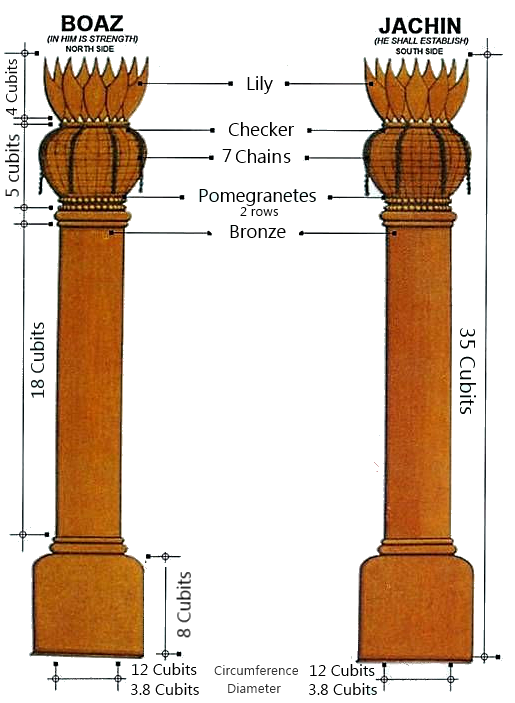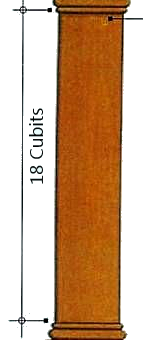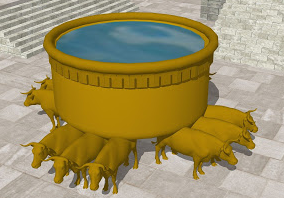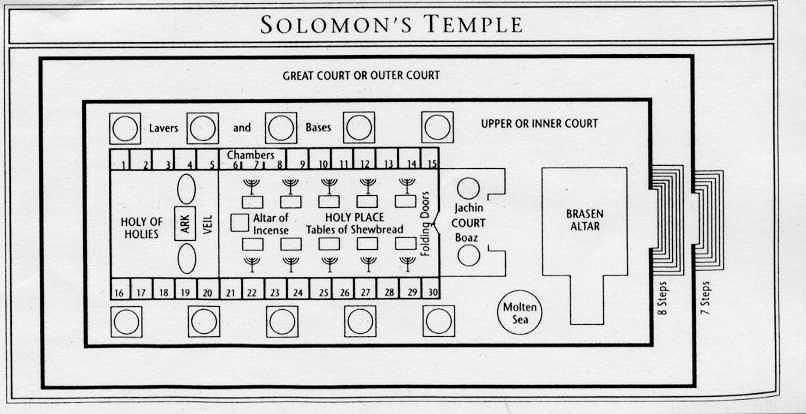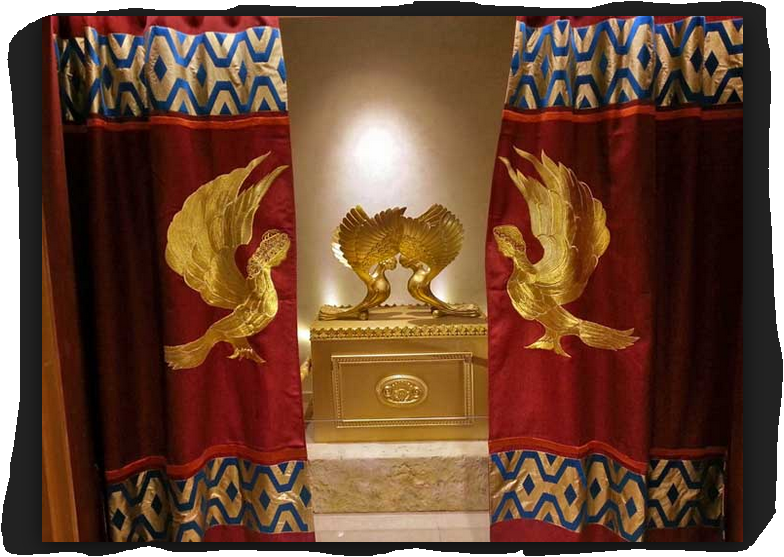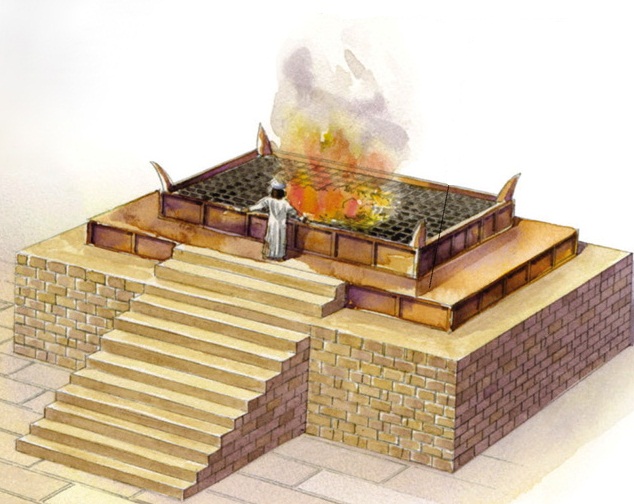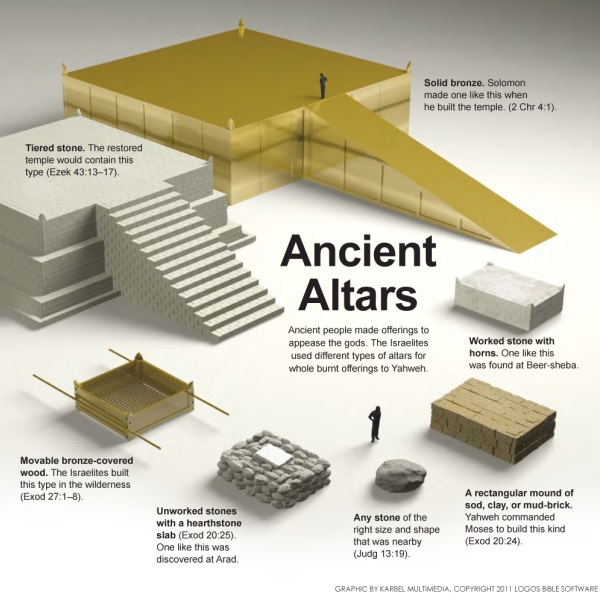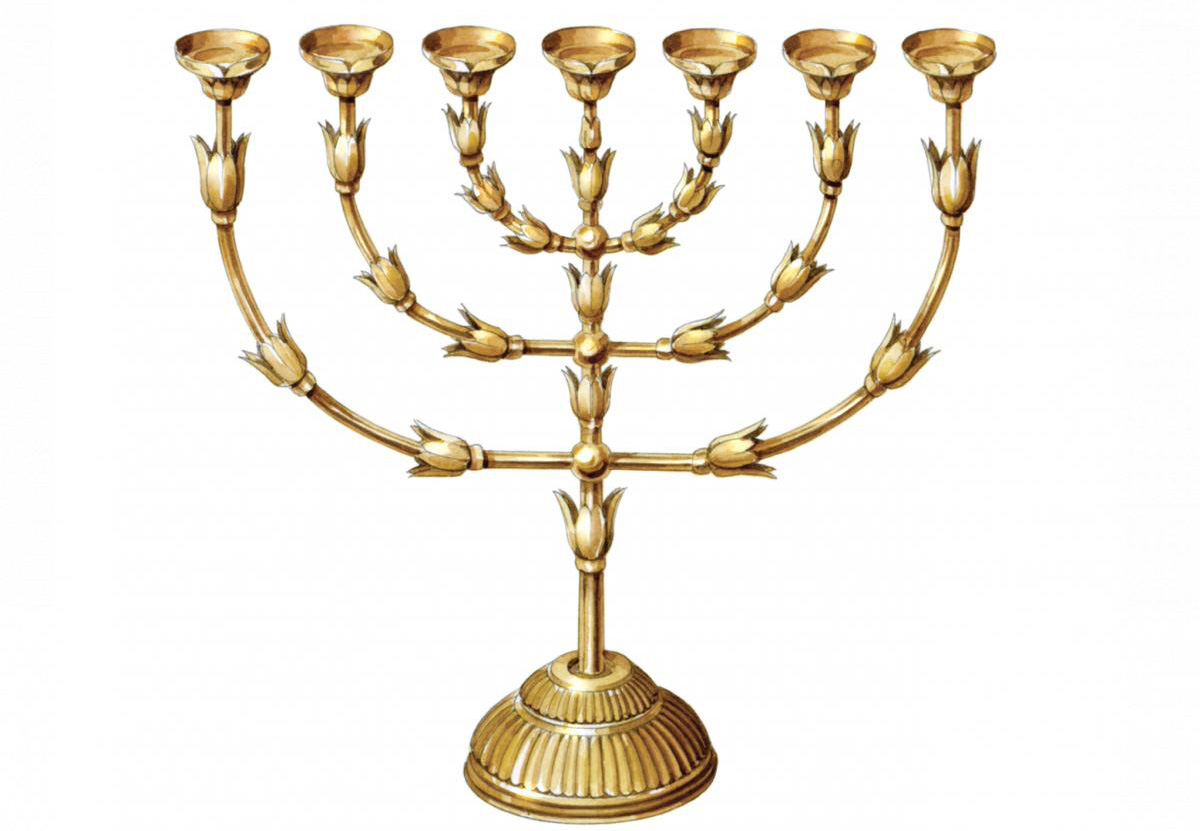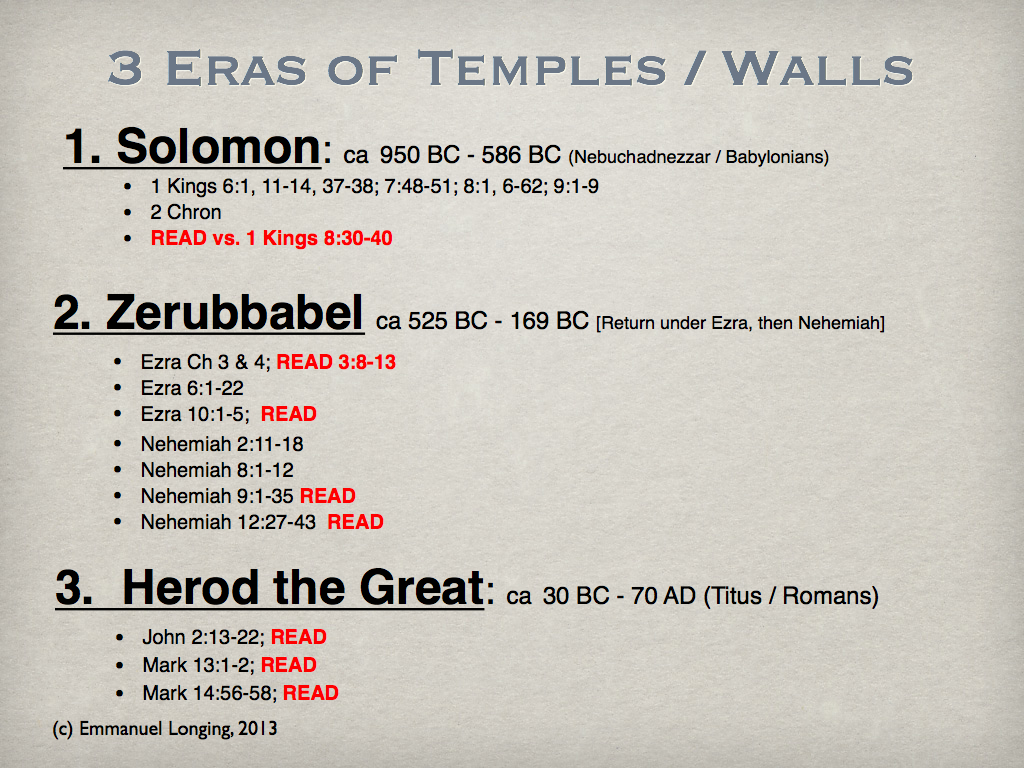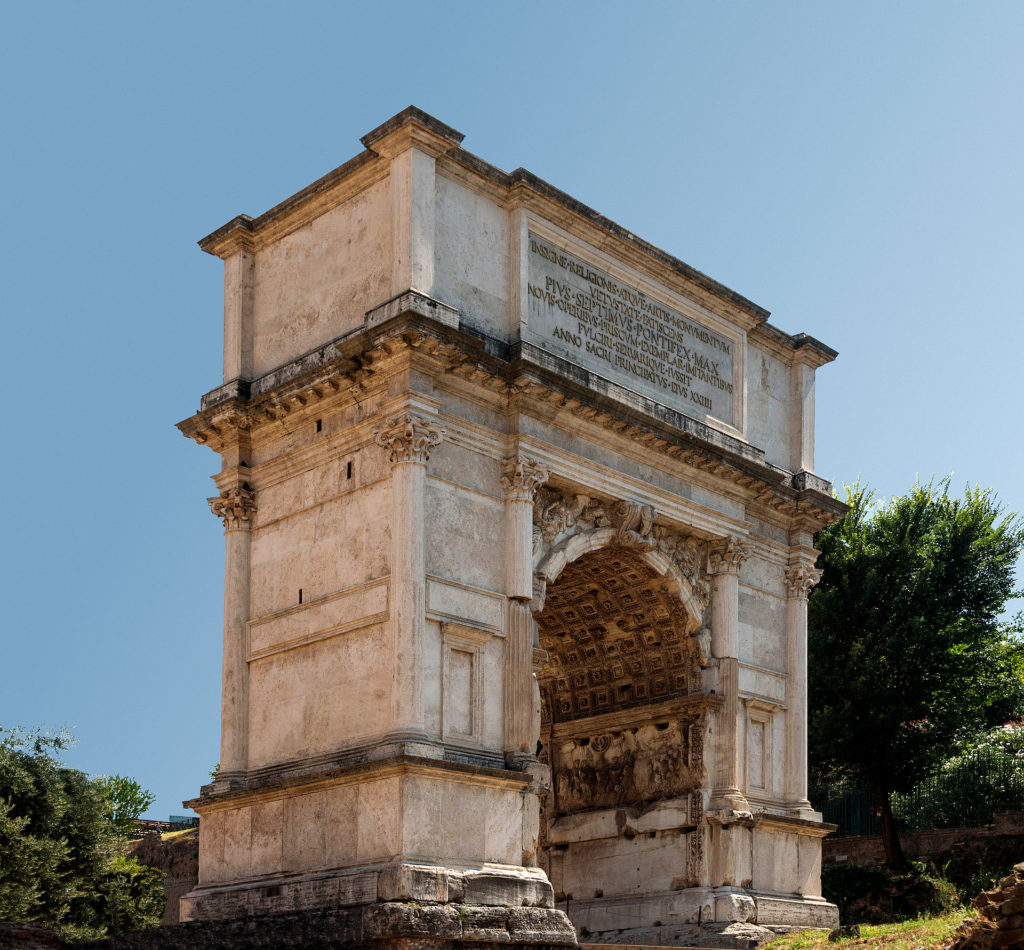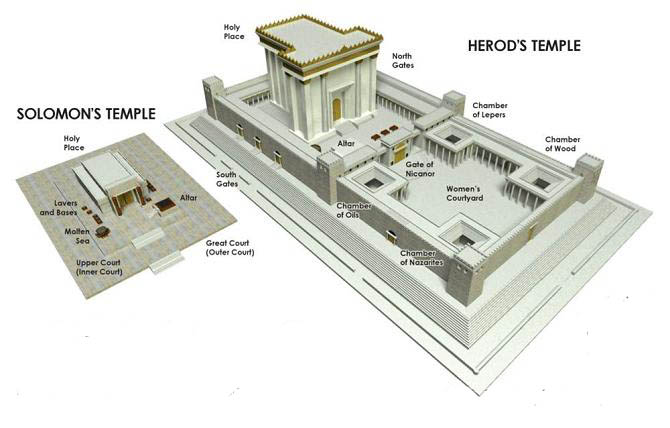Solomons Temple :: Temple Mount
THE THRESHING FLOOR at MOUNT MORIAH
Strong’s Hebrew ConcordanceMoriah [h4179] occurs 2 times in 2 verses
Moriah = “chosen by Jehovah”
the place where Abraham took Isaac for sacrifice
the mount on the eastern edge of Jerusalem on which Solomon built the temple
Genesis 22 : The Offering of Isaac (John 3:16-21; Romans 5:6-11)
1And it came to pass after these things, that God did tempt Abraham, and said to him, Abraham: and he said, Behold, here I am. 2And he said, Take now your son, your only son Isaac, whom you love, and get you into the land of Moriah [h4179]; and offer him there for a burnt offering on one of the mountains which I will tell you of.
GOD CHOSE ABRAHAM OUT OF BABYLON and then tempted him by telling him to offer up Isaac as a burnt offering in MOUNT MORIAH, which was a common pagan practice that came out of Babylon. When God saw that Abraham acted upon God’s request, God knew that he feared Him, and did not withhold His only son from Him. Abraham then offered up a substitute offering of a ram in Isaac’s place.
MOUNT MORIAH is the place where David would purchase the threshing floor from Ornan the Jebusite and establish Jerusalem for 600 shekels of gold. (1 Chronicles 24). He would also purchase oxen for 50 shekels of silver. (2 Samuel 24). This would be where Solomon, David’s son, who was the wisest on earth, laid the foundation and built the temple made with hands, which took 7 years to make.
2 Chronicles 3 : Temple Construction Begins (1 Kings 6:1-4)
1Then Solomon began to build the house of the LORD at Jerusalem in mount Moriah [h4179], where the Lord appeared to David his father, in the place that David had prepared in the threshing floor of Ornan the Jebusite. 2And he began to build in the second day of the second month, in the fourth year of his reign.
1 Chronicles 22 : David’s Preparations for the Temple
1Then David said, This is the house of the LORD God, and this is the altar of the burnt offering for Israel.
2And David commanded to gather together the strangers that were in the land of Israel; and he set masons to hew worked stones to build the house of God. 3And David prepared iron in abundance for the nails for the doors of the gates, and for the joinings; and brass in abundance without weight; 4Also cedar trees in abundance: for the Zidonians and they of Tyre brought much cedar wood to David. 5And David said, Solomon my son is young and tender, and the house that is to be built for the LORD must be exceeding magnificent, of fame and of glory throughout all countries: I will therefore now make preparation for it. So David prepared abundantly before his death.
Solomon Anointed to Build the Temple
6Then he called for Solomon his son, and charged him to build an house for the LORD God of Israel. 7And David said to Solomon, My son, as for me, it was in my mind to build an house to the name of the LORD my God: 8But the word of the LORD came to me, saying, You have shed blood abundantly, and have made great wars: you shall not build an house to my name, because you have shed much blood on the earth in my sight. 9Behold, a son shall be born to you, who shall be a man of rest; and I will give him rest from all his enemies round about: for his name shall be Solomon, and I will give peace and quietness to Israel in his days. 10He shall build an house for my name; and he shall be my son, and I will be his father; and I will establish the throne of his kingdom over Israel for ever. 11Now, my son, the LORD be with you; and prosper you, and build the house of the LORD your God, as he has said of you. 12Only the LORD give you wisdom and understanding, and give you charge concerning Israel, that you may keep the law of the LORD your God. 13Then shall you prosper, if you take heed to fulfill the statutes and judgments which the LORD charged Moses with concerning Israel: be strong, and of good courage; dread not, nor be dismayed. 14Now, behold, in my trouble I have prepared for the house of the LORD an hundred thousand talents of gold, and a thousand thousand talents of silver; and of brass and iron without weight; for it is in abundance: timber also and stone have I prepared; and you may add thereto. 15Moreover there are workmen with you in abundance, hewers and workers of stone and timber, and all manner of cunning men for every manner of work. 16Of the gold, the silver, and the brass, and the iron, there is no number. Arise therefore, and be doing, and the LORD be with you.
17David also commanded all the princes of Israel to help Solomon his son, saying, 18Is not the LORD your God with you? and has he not given you rest on every side? for he has given the inhabitants of the land into my hand; and the land is subdued before the LORD, and before his people. 19Now set your heart and your soul to seek the LORD your God; arise therefore, and build you the sanctuary of the LORD God, to bring the ark of the covenant of the LORD, and the holy vessels of God, into the house that is to be built to the name of the LORD.
1 Kings 5 : Preparations for the Temple (2 Chronicles 2:1-10)
1And Hiram king of Tyre sent his servants to Solomon; for he had heard that they had anointed him king in the room of his father: for Hiram was ever a lover of David. 2And Solomon sent to Hiram, saying, 3You know how that David my father could not build an house to the name of the LORD his God for the wars which were about him on every side, until the LORD put them under the soles of his feet. 4But now the LORD my God has given me rest on every side, so that there is neither adversary nor evil result. 5And, behold, I purpose to build an house to the name of the LORD my God, as the LORD spoke to David my father, saying, Your son, whom I will set on your throne in your room, he shall build an house to my name. 6Now therefore command you that they hew me cedar trees out of Lebanon; and my servants shall be with your servants: and to you will I give hire for your servants according to all that you shall appoint: for you know that there is not among us any that can skill to hew timber like to the Sidonians.
7And it came to pass, when Hiram heard the words of Solomon, that he rejoiced greatly, and said, Blessed be the LORD this day, which has given to David a wise son over this great people. 8And Hiram sent to Solomon, saying, I have considered the things which you sent to me for: and I will do all your desire concerning timber of cedar, and concerning timber of fir. 9My servants shall bring them down from Lebanon to the sea: and I will convey them by sea in floats to the place that you shall appoint me, and will cause them to be discharged there, and you shall receive them: and you shall accomplish my desire, in giving food for my household. 10So Hiram gave Solomon cedar trees and fir trees according to all his desire. 11And Solomon gave Hiram 20,000 measures of wheat for food to his household, and 20d measures of pure oil: thus gave Solomon to Hiram year by year. 12And the LORD gave Solomon wisdom, as he promised him: and there was peace between Hiram and Solomon; and they two made a league tmogether.
Solomon’s Workmen and Laborers
13And king Solomon raised a levy out of all Israel; and the levy was 30,000 men. 14And he sent them to Lebanon, 10,000 a month by courses: a month they were in Lebanon, and 2 months at home: and Adoniram was over the levy. 15And Solomon had 70,000 that bore burdens, and 80,000 hewers in the mountains; 16Beside the chief of Solomon’s officers which were over the work, 3,300 , which ruled over the people that worked in the work. 17 And the king commanded, and they brought great stones, costly stones, and hewed stones, to lay the foundation of the house. 18And Solomon’s builders and Hiram’s builders did hew them, and the stone squarers: so they prepared timber and stones to build the house.
30,000 Forced Laborers
70,000 Transporters
80,000 Hewers of Stone
3,300Chief deputies (overseers of project)
183,300 total
All Calculations based off 18″ cubit
cubit – a measure of distance (the forearm), roughly 18″ (.5m). There are several cubits used in the OT, the cubit of a man or common cubit (Dt 3.11), the legal cubit or cubit of the sanctuary (Eze 40.5) plus others. See a Bible Dictionary for a complete treatment.
אַמָּה ʼammâh, “a mother”
1 Kings 6 : Solomon Builds the Temple (2 Chronicles 3:1-2)
1And it came to pass in the 480th year after the children of Israel were come out of the land of Egypt, in the 4th year of Solomon’s reign over Israel, in the month Zif, which is the 2nd month, that he began to build the house of the LORD. 2And the house which king Solomon built for the LORD, the length thereof was 60 cubits, and the breadth thereof 20 cubits, and the height thereof 30 cubits.
TEMPLE DIMENSIONS
CUBITS YARDS FEET INCHES Length 60 30 90′ 1080″ width 20 10 30′ 360″ height 30 15 45′ 540″ SA 72002 18002 162002 23328002
The Porch
3And the porch before the temple of the house, 20 cubits was the length thereof, according to the breadth of the house; and 10 cubits was the breadth thereof before the house.
SOLOMONS PORCH
PORCH DIMENSIONS
CUBITS YARDS FEET INCHES Length 20 10 30′ 360″ width 10 5 15′ 180″ Height 120 26.6667 80′ 2160″ SA 7600 900.01 8100 2,462,400
2ND CHRONICLES 2:
4The porch which was in front of the house was as long as the width of the house, 20 cubits, and the height 120;
4And for the house he made windows of narrow lights.
Side Chambers
5And against the wall of the house he built chambers round about, against the walls of the house round about, both of the temple and of the oracle: and he made chambers round about: 6The nethermost chamber was 5 cubits broad, and the middle was 6 cubits broad, and the third was 7 cubits broad: for without in the wall of the house he made narrowed rests round about, that the beams should not be fastened in the walls of the house.7And the house, when it was in building, was built of stone made ready before it was brought thither: so that there was neither hammer nor ax nor any tool of iron heard in the house, while it was in building. 8The door for the middle chamber was in the right side of the house: and they went up with winding stairs into the middle chamber, and out of the middle into the third. 9So he built the house, and finished it; and covered the house with beams and boards of cedar. 10And then he built chambers against all the house, 5 cubits high: and they rested on the house with timber of cedar.
Side Chambers
DIMENSIONS OF 1st CHAMBER
CUBITS YARDS FEET INCHES width 5 2.5 7.6′ 90″ height 5 2.5 7.6′ 90″
DIMENSIONS OF 2nd CHAMBER
8The door for the middle chamber was in the right side of the house: and they went up with winding stairs into the middle chamber, and out of the middle into the third.
CUBITS YARDS FEET INCHES width 6 3 9′ 108″ height 5 2.5 7.6′ 90″
DIMENSIONS OF 3rd CHAMBER
CUBITS YARDS FEET INCHES width 7 3.5 10.6′ 126″ height 5 2.5 7.6′ 90″
11And the word of the LORD came to Solomon, saying, 12Concerning this house which you are in building, if you will walk in my statutes, and execute my judgments, and keep all my commandments to walk in them; then will I perform my word with you, which I spoke to David your father: 13And I will dwell among the children of Israel, and will not forsake my people Israel. 14So Solomon built the house, and finished it. 15And he built the walls of the house within with boards of cedar, both the floor of the house, and the walls of the ceiling: and he covered them on the inside with wood, and covered the floor of the house with planks of fir. 16And he built 20 cubits on the sides of the house, both the floor and the walls with boards of cedar: he even built them for it within, even for the oracle, even for the most holy place. 17And the house, that is, the temple before it, was 40 cubits long. 18And the cedar of the house within was carved with knops and open flowers: all was cedar; there was no stone seen.
House
DIMENSIONS OF THE HOUSE
CUBITS YARDS FEET INCHES length 40 20 60′ 720″ width 20 10 30′ 360″ height 30 15 45′ 540″
HOUSE INTERIOR
- The Walls, Floors, and Ceiling : Boards of Cedar
- The Floor was then covered with Fir planks.
the cedar of the house within was carved with knops and open flowers: all was cedar; there was no stone seen. Solomon overlaid the house within with pure gold:and he made a partition by the chains of gold before the oracle; and he overlaid it with gold. 22And the whole house he overlaid with gold, until he had finished all the house: also the whole altar that was by the oracle he overlaid with gold. 29And he carved all the walls of the house round about with carved figures of cherubim and palm trees and open flowers, within and without. 30And the floors of the house he overlaid with gold, within and without.
The Oracle : Holy of Holies
19And the oracle he prepared in the house within, to set there the ark of the covenant of the LORD. 20And the oracle in the forepart was 20 cubits in length, and 20 cubits in breadth, and 20 cubits in the height thereof: and he overlaid it with pure gold; and so covered the altar which was of cedar.
21So Solomon overlaid the house within with pure gold: and he made a partition by the chains of gold before the oracle; and he overlaid it with gold. 22And the whole house he overlaid with gold, until he had finished all the house: also the whole altar that was by the oracle he overlaid with gold.
23And within the oracle he made 2 cherubim of olive tree, each 10 cubits high. 24And 5 cubits was the one wing of the cherub, and 5 cubits the other wing of the cherub: from the uttermost part of the one wing to the uttermost part of the other were 10 cubits. 25And the other cherub was 10 cubits: both the cherubim were of one measure and one size. 26The height of the one cherub was 10 cubits, and so was it of the other cherub. 27And he set the cherubim within the inner house: and they stretched forth the wings of the cherubim, so that the wing of the one touched the one wall, and the wing of the other cherub touched the other wall; and their wings touched one another in the middle of the house. 28And he overlaid the cherubim with gold.29And he carved all the walls of the house round about with carved figures of cherubim and palm trees and open flowers, within and without. 30And the floors of the house he overlaid with gold, within and without.
oracle :: the holy of holies
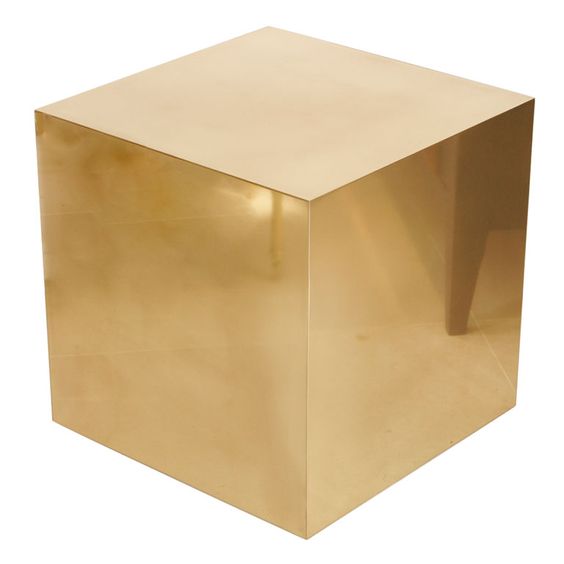
DIMENSIONS OF THE HOLY OF HOLIES
CUBITS YARDS FEET INCHES LENGTH 20 10 30′ 360″ WIDTH 20 10 30′ 360″ Height 20 10 30′ 360″ SA 24002 6002 54002′ 7776002”
Cherubim (2 Chronicles 3:11-13)
DIMENSIONS OF CHERUBIM
CUBITS YARDS FEET INCHES Height 10 5 15′ 180″ width 20 10 30′ 360″ Width derived from each wing being: (4 total)
CUBITS YARDS FEET INCHES LENGTH 5 2.5 7.6′ 90″
DOOR OF HOLY OF HOLIES MADE OF OLIVE TREE
CUBITS YARDS FEET INCHES LENGTH 4 2 6′ 72″
the entering of the oracle he made doors of olive tree: the lintel and side posts were a 5th part of the wall. 32The 2 doors also were of olive tree; and he carved on them carvings of cherubim and palm trees and open flowers, and overlaid them with gold, and spread gold on the cherubim, and on the palm trees.
The Doors
31And for the entering of the oracle he made doors of olive tree: the lintel and side posts were a 5th part of the wall. 32The 2 doors also were of olive tree; and he carved on them carvings of cherubim and palm trees and open flowers, and overlaid them with gold, and spread gold on the cherubim, and on the palm trees.
33So also made he for the door of the temple posts of olive tree, a 4th part of the wall. 34And the 2 doors were of fir tree: the 2 leaves of the one door were folding, and the 2 leaves of the other door were folding. 35And he carved thereon cherubim and palm trees and open flowers: and covered them with gold fitted on the carved work.
Temple Doors
DIMENSIONS OF TEMPLE DOORS
CUBITS YARDS FEET INCHES LENGTH 5 2.5 7.6′ 90″
33So also made he for the door of the temple posts of olive tree, a 4th part of the wall. 34And the 2 doors were of fir tree: the 2 leaves of the one door were folding, and the 2 leaves of the other door were folding. 35And he carved thereon cherubim and palm trees and open flowers: and covered them with gold fitted on the carved work.
The Courtyard : Foundation
36And he built the inner court with 3 rows of hewed stone, and a row of cedar beams. 37In the 4th year was the foundation of the house of the LORD laid, in the month Zif: 38And in the 11th year, in the month Bul, which is the 8th month, was the house finished throughout all the parts thereof, and according to all the fashion of it. So was he 7 years in building it.
1 Kings 7 : the work of hiram(2 Chronicles 4:1-5)
13And king Solomon sent and fetched Hiram out of Tyre. 14He was a widow’s son of the tribe of Naphtali, and his father was a man of Tyre, a worker in brass: and he was filled with wisdom, and understanding, and cunning to work all works in brass. And he came to king Solomon, and worked all his work.
15For he cast two pillars of brass, of eighteen cubits high apiece: and a line of twelve cubits did compass either of them about.16And he made two capitals of molten brass, to set on the tops of the pillars: the height of the one capital was five cubits, and the height of the other capital was five cubits: 17And nets of checker work, and wreaths of chain work, for the capitals which were on the top of the pillars; seven for the one capital, and seven for the other capital. 18And he made the pillars, and two rows round about on the one network, to cover the capitals that were on the top, with pomegranates: and so did he for the other capital. 19And the capitals that were on the top of the pillars were of lily work in the porch, four cubits. 20And the capitals on the two pillars had pomegranates also above, over against the belly[h990] which was by the network: and the pomegranates were two hundred in rows round about on the other capital. 21And he set up the pillars in the porch of the temple: and he set up the right pillar, and called the name thereof Jachin: and he set up the left pillar, and called the name thereof Boaz. 22And on the top of the pillars was lily work: so was the work of the pillars finished.
Strong’s Hebrew ConcordanceBelly [h990] בֶּטֶן beṭen, beh’-ten occurs34times in 32verses
- Belly = “to be hollow; especially the womb;”
- also the bosom or body of anything:—belly, body, as they be born, within, womb.
- belly, womb, body, belly, abdomen
- as seat of hunger; as seat of mental faculties; of depth of Sheol (fig.)
brass Pillars
LILY WORK (which completed the pillars)
CUBITS YARDS FEET INCHES HEIGHT 4 2 6′ 72″
CHAPITER (Capital bowls of Columns)
CUBITS YARDS FEET INCHES HEIGHT 5 2.5 7’6″ 90″
7 Networks to cover chapiters :: 14 Total
2 rows of 100 pomegranates for networks above capitals ::400 total
- Used to cover the 2 bowls of the chapiters | capitals
Strong’s Hebrew ConcordanceChapiter [h3805] כֹתֶרֶת kôthereth, ko-theh’-reth
- Chapiter = “the capital of a column:—chapiter.”
- a primitive root;
feminine active participle of H3803; כָּתַר kâthar, kaw-thar’;
- “to enclose;”
- hence (in a friendly sense) to crown,
- (in a hostile one) to besiege;
- also to wait (as restraining oneself):
- —beset round, compass about, be crowned, inclose round, suffer.
Strong’s Hebrew ConcordanceNetwork [h7639] שְׂבָכָה sᵉbâkâh
- net-work = “(in hunting) a snare, (in architecture) a ballustrade;”
- also a reticulated ornament to a pillar:
- —checker, lattice, network, snare, wreath(-enwork).
- nets of checker work
feminine of H7638; an unused root [h7638] שָׂבָךְ sâbâk, saw-bawk’; (1x) “to intwine;”
- a netting (ornament to the capital of a column):—net.
- network, lattice-work, net, netting, lattice
- net-ornament (on pillars), network, toils (for catching animals)
Strong’s Hebrew ConcordancePommel [h1543] גֻּלָּה gullâh, gool-law
- Pommel = “a fountain, bowl or globe (all as round):—bowl, pommel, spring.”
- bowl, spring, basin
feminine from H1556; גָּלַל gâlal, gaw-lal’; (18x)
- “to roll (literally or figuratively):”
- —commit, remove, roll (away, down, together), run down, seek occasion, trust, wallow.
- a primitive root;
Strong’s Hebrew ConcordanceWreath [h7639] שְׂבָכָה sᵉbâkâh, seb-aw-kaw’
- Wreath = a net-work, i.e. (in hunting) a snare, (in architecture) a ballustrade
- also a reticulated ornament to a pillar:—checker, lattice, network, snare, wreath(-enwork).
- feminine of H7638;
SHAFT OF PILLARS
CUBITS YARDS FEET INCHES HEIGHT 18 9 27′ 324″ CIRCUM (3) 12 6 18′ 216″ DIAMETER 4 2 6′ 72″ RADIUS 2 1 3′ 36″ SURFACE AREA 251.3274 62.83 565.486677′ 81430.08″
CIRCUMFERENCE = 3.14159265 x diameter
CUBITS YARDS FEET INCHES height 18 9 27 324 circum (3.14) 12 6 18 216 diameter 3.81972 1.90986 5.7295 68.75499 radius 1.90986 0.95493 2.86479 34.377495 surface area 238.91853 59.72963 537.566 77409.6
BASE OF PILLARS
CUBITS YARDS FEET INCHES HEIGHT 8 4 12′ 144″
SHAFT + BASE
CUBITS YARDS FEET INCHES HEIGHT 26 13 39″ 468″
SHAFT + BASE + CAPITAL
CUBITS YARDS FEET INCHES HEIGHT 31 15.5 46.6′ 558″
SHAFT + CAPITAL
CUBITS YARDS FEET INCHES HEIGHT 23 11.5 34.6″ 414″
SHAFT + CAPITAL + LILY
CUBITS YARDS FEET INCHES HEIGHT 27 23.6 40.6″ 486″
TOTAL
CUBITS YARDS FEET INCHES HEIGHT 35 17.5 52.6″ 630″
Strong’s Hebrew ConcordanceJachin [h3199] יָכִין Yâkîyn, yaw-keen’
- Jachin = “he (or it) will establish;” The “South” Pillar on the Right
- the 4th son of Simeon and founder of the family of Jachinites
a priest and the head of the 21st course in the time of David
a post-exilic priest in the time of Nehemiah
from H3559; כּוּןkûwn, koon;
- a primitive root; properly, to be erect (i.e. stand perpendicular);
- hence (causatively) to set up, in a great variety of applications,
- whether literal (establish, fix, prepare, apply),
- or figurative (appoint, render sure, proper or prosperous)
- :—certain(-ty), confirm, direct, faithfulness, fashion, fasten, firm, be fitted, be fixed, frame, be meet, ordain, order, perfect, (make) preparation, prepare (self), provide, make provision, (be, make) ready, right, set (aright, fast, forth), be stable,
Strong’s Hebrew ConcordanceBoaz [h1162] יָכִין Yâkîyn, yaw-keen’
- Boaz = “fleetness” The “North” Pillar on the Left
- from an unused root of uncertain meaning;
- ancestor of David, kinsman-redeemer to Ruth, daughter-in-law of Naomi
- also the name of a pillar in front of the temple:—Boaz.
The Sea of Cast Metal
23And he made a molten sea, ten cubits from the one brim to the other: it was round all about, and his height was five cubits: and a line of thirty cubits did compass it round about. 24And under the brim of it round about there were knops compassing it, ten in a cubit, compassing the sea round about: the knops were cast in two rows, when it was cast. 25It stood on twelve oxen, three looking toward the north, and three looking toward the west, and three looking toward the south, and three looking toward the east: and the sea was set above on them, and all their hinder parts were inward. 26And it was an hand breadth thick, and the brim thereof was worked like the brim of a cup, with flowers of lilies: it contained two thousand baths.
Cast Metal Sea
(a handbreadth thick)
DIMENSIONS OF CAST METAL SEA
CUBITS YARDS FEET INCHES HEIGHT 5 2.5 7’6″ 90″ CIRCUMFERENCE 31.4 15.7 47’1″ 565.2″ CIRCUMFERENCE 30 15 45′ 540″ DIAMETER 10 5 15′ 180″ RADIUS 5 2.5 7’6″ 90″
12 oxen, 10 cubits high encircling the sea, in 2 rows, cast in one piece
CUBITS YARDS FEET INCHES HEIGHT 10 5 15′ 180″
THE BRIM was made like a lily blossom and could hold2000 baths
- 1 bath = 72 hin ::: 144,000 hin
- 1 bath = 216 kabs ::: 432,000 kabs
- 1 bath = 864 logs ::: 1,728,000 logs
- 1 homer/kor = 10 baths ::: 200 homers/kors
600 knops compassed underneath the brim round about in 2 rows
300per row (10 per cubit)
It was used for priests to wash in which wasright side of house (southeast)
Sea set on top with hind quarters turned inward
The Ten Bases
27And he made ten bases of brass; four cubits was the length of one base, and four cubits the breadth thereof, and three cubits the height of it. 28And the work of the bases was on this manner: they had borders, and the borders were between the ledges:29And on the borders that were between the ledges were lions, oxen, and cherubim: and on the ledges there was a base above: and beneath the lions and oxen were certain additions made of thin work. 30And every base had four brazen wheels, and plates of brass: and the four corners thereof had supports: under the laver were supports molten, at the side of every addition. 31And the mouth of it within the capital and above was a cubit: but the mouth thereof was round after the work of the base, a cubit and an half: and also on the mouth of it were engravings with their borders, foursquare, not round. 32And under the borders were four wheels; and the axletrees of the wheels were joined to the base: and the height of a wheel was a cubit and half a cubit. 33And the work of the wheels was like the work of a chariot wheel: their axletrees, and their naves, and their felloes, and their spokes, were all molten. 34And there were four supports to the four corners of one base: and the supports were of the very base itself. 35And in the top of the base was there a round compass of half a cubit high: and on the top of the base the ledges thereof and the borders thereof were of the same. 36For on the plates of the ledges thereof, and on the borders thereof, he graved cherubim, lions, and palm trees, according to the proportion of every one, and additions round about. 37After this manner he made the ten bases: all of them had one casting, one measure, and one size.
The Ten Bronze Basins (2 Chronicles 4:6-8)
38Then made he ten lavers of brass: one laver contained forty baths: and every laver was four cubits: and on every one of the ten bases one laver. 39And he put five bases on the right side of the house, and five on the left side of the house: and he set the sea on the right side of the house eastward over against the south.
10 Bronze Bases
DIMENSIONS OF BASES
CUBITS YARDS FEET INCHES LENGTH 4 2 6′ 72″ WIDTH 4 2 6′ 72″ HEIGHT 3 1.5 4’6″ 54″
29And on the borders that were between the ledges were lions, oxen, and cherubim: and on the ledges there was a base above: and beneath the lions and oxen were certain additions made of thin [h4714] work.
THE MOUTH WITHIN THE CAPITAL (SQUARE)
CUBITS YARDS FEET INCHES height 1 1.5′ 1′
31And the mouth of it within the capital and above was a cubit:
THE MOUTH THEREOF (ROUND)
CUBITS YARDS FEET INCHES height 1.5 2.25′ 27″
but the mouth thereof was round after the work of the base, a cubit and an half: and also on the mouth of it were engravings with their borders, foursquare, not round.
HEIGHT OF COMPASS IN TOP OF BASE
CUBITS YARDS FEET INCHES height 1 1.5′ 18″
35And in the top of the base was there a round compass of half a cubit high: and on the top of the base the ledges thereof and the borders thereof were of the same. 36For on the plates of the ledges thereof, and on the borders thereof, he graved cherubim, lions, and palm trees, according to the proportion of every one, and additions round about.
BRASS WHEELS
- 4on each of the10 (40 total)
CUBITS YARDS FEET INCHES Diameter 1.5 .75 2’3″ 27″ radius .75 .375 1.125 13.5″ Circ (pi) 4.71 2.355 7.065 84.78 Circ (3) 4.5 2.25 6’9″ 81 total 4x 18 9 27′ 324″
33And the work of the wheels was like the work of a chariot wheel: their axletrees, and their naves, and their felloes, and their spokes, were all molten (cast metal).
10 brass Basins | lavers WITHIN BASES
EACH LAVER CONTAINED 40 baths or:
- 2,880 hin
- 8,640 kabs
- 34,560 logs
- 4 homers/kors
TOTAL FOR 10 LAVERS IS 400 baths or:
- 28,800 hin
- 86,400 kabs
- 345,600 logs
- 40 homers/kors
DIMENSIONS FOR LAVERS
CUBITS YARDS FEET INCHES Diameter 4 2 6′ 72″ radius 2 1 3 36″ Circ (pi) 12.56 6.28 18.84′ 226.08″ Circ (3) 12 6 18′ 216″
The Vessels (2 Chronicles 4:11-18)
40And Hiram made the lavers, and the shovels, and the basins. So Hiram made an end of doing all the work that he made king Solomon for the house of the LORD: 41The two pillars, and the two bowls of the capitals that were on the top of the two pillars; and the two networks, to cover the two bowls of the capitals which were on the top of the pillars; 42And four hundred pomegranates for the two networks, even two rows of pomegranates for one network, to cover the two bowls of the capitals that were on the pillars; 43And the ten bases, and ten lavers on the bases; 44And one sea, and twelve oxen under the sea;45And the pots, and the shovels, and the basins: and all these vessels, which Hiram made to king Solomon for the house of the LORD, were of bright brass. 46In the plain of Jordan did the king cast them, in the clay ground between Succoth and Zarthan.47And Solomon left all the vessels unweighed, because they were exceeding many: neither was the weight of the brass found out.
48And Solomon made all the vessels that pertained to the house of the LORD: the altar of gold, and the table of gold, whereupon the show bread was, 49And the candlesticks of pure gold, five on the right side, and five on the left, before the oracle, with the flowers, and the lamps, and the tongs of gold, 50And the bowls, and the snuffers, and the basins, and the spoons, and the censers of pure gold; and the hinges of gold, both for the doors of the inner house, the most holy place, and for the doors of the house, to wit, of the temple.
51So was ended all the work that king Solomon made for the house of the LORD. And Solomon brought in the things which David his father had dedicated; even the silver, and the gold, and the vessels, did he put among the treasures of the house of the LORD.
North
South
2 Chronicles 2 : Preparations for the Temple (1 Kings 5:1-12)
1And Solomon determined to build an house for the name of the LORD, and an house for his kingdom. 2And Solomon told out three score and ten thousand men to bear burdens, and fourscore thousand to hew in the mountain, and three thousand and six hundred to oversee them.3And Solomon sent to Huram the king of Tyre, saying, As you did deal with David my father, and did send him cedars to build him an house to dwell therein, even so deal with me. 4Behold, I build an house to the name of the LORD my God, to dedicate i t to him, and to burn before him sweet incense, and for the continual show bread, and for the burnt offerings morning and evening, on the sabbaths, and on the new moons, and on the solemn feasts of the LORD our God. This is an ordinance for ever to Israel. 5And the house which I build is great: for great is our God above all gods. 6But who is able to build him an house, seeing the heaven and heaven of heavens cannot contain him? who am I then, that I should build him an house, save only to burn sacrifice before him? 7Send me now therefore a man cunning to work in gold, and in silver, and in brass, and in iron, and in purple, and crimson, and blue, and that can skill to grave with the cunning men that are with me in Judah and in Jerusalem, whom David my father did provide. 8Send me also cedar trees, fir trees, and algum trees, out of Lebanon: for I know that your servants can skill to cut timber in Lebanon; and, behold, my servants shall be with your servants, 9Even to prepare me timber in abundance: for the house which I am about to build shall be wonderful great. 10And, behold, I will give to your servants, the hewers that cut timber, twenty thousand measures of beaten wheat, and twenty thousand measures of barley, and twenty thousand baths of wine, and twenty thousand baths of oil.
Huram Agrees to Assist
11Then Huram the king of Tyre answered in writing, which he sent to Solomon, Because the LORD has loved his people, he has made you king over them. 12Huram said moreover, Blessed be the LORD God of Israel, that made heaven and earth, who has given to David the king a wise son, endued with prudence and understanding, that might build an house for the LORD, and an house for his kingdom.
13And now I have sent a cunning man, endued with understanding, of Huram my father’s, 14The son of a woman of the daughters of Dan, and his father was a man of Tyre, skillful to work in gold, and in silver, in brass, in iron, in stone, and in timber, in purple, in blue, and in fine linen, and in crimson; also to grave any manner of engraving, and to find out every device which shall be put to him, with your cunning men, and with the cunning men of my lord David your father. 15Now therefore the wheat, and the barley, the oil, and the wine, which my lord has spoken of, let him send to his servants: 16And we will cut wood out of Lebanon, as much as you shall need: and we will bring it to you in floats by sea to Joppa; and you shall carry it up to Jerusalem.
17And Solomon numbered all the strangers that were in the land of Israel, after the numbering with which David his father had numbered them; and they were found an 153,600. 18And he set 70,000 of them to be bearers of burdens, and 80,000 to be hewers in the mountain, and 3,600 overseers to set the people a work.
1 Kings the number of strangers was not mentioned
1 Kings has 3,300 overseers :: 2 Chronicles has 3,600 overseers
2 Chronicles 3 : Temple Construction Begins (1 Kings 6:1-4)
1Then Solomon began to build the house of the LORD at Jerusalem in mount Moriah, where the Lord appeared to David his father, in the place that David had prepared in the threshing floor of Ornan the Jebusite. 2And he began to build in the second day of the second month, in the fourth year of his reign.
Dimensions and Materials
3Now these are the things wherein Solomon was instructed for the building of the house of God. The length by cubits after the first measure was three score cubits, and the breadth twenty cubits. 4And the porch that was in the front of the house, the length of it was according to the breadth of the house, twenty cubits, and the height was an hundred and twenty: and he overlaid it within with pure gold. 5And the greater house he paneled with fir tree, which he overlaid with fine gold, and set thereon palm trees and chains. 6And he garnished the house with precious stones for beauty: and the gold was gold of Parvaim. 7He overlaid also the house, the beams, the posts, and the walls thereof, and the doors thereof, with gold; and graved cherubim on the walls.
8And he made the most holy house, the length whereof was according to the breadth of the house, twenty cubits, and the breadth thereof twenty cubits: and he overlaid it with fine gold, amounting to 600 talents. 9And the weight of the nails was 50 shekels of gold. And he overlaid the upper chambers with gold. 10And in the most holy house he made two cherubim of image work, and overlaid them with gold.
The Cherubim (1 Kings 6:23-30)
11And the wings of the cherubim were twenty cubits long: one wing of the one cherub was five cubits, reaching to the wall of the house: and the other wing was likewise five cubits, reaching to the wing of the other cherub. 12And one wing of the other cherub was five cubits, reaching to the wall of the house: and the other wing was five cubits also, joining to the wing of the other cherub. 13The wings of these cherubim spread themselves forth twenty cubits: and they stood on their feet, and their faces were inward.
The Veil
14And he made the veil of blue, and purple, and crimson, and fine linen, and worked cherubim thereon.
THE VEIL
The Pillars
15Also he made before the house two pillars of thirty and five cubits high, and the capital that was on the top of each of them was five cubits. 16And he made chains, as in the oracle, and put them on the heads of the pillars; and made an hundred pomegranates, and put them on the chains. 17And he reared up the pillars before the temple, one on the right hand, and the other on the left; and called the name of that on the right hand Jachin, and the name of that on the left Boaz.
WEIGHT OF GOLD OVERLAID IN THE ORACLE : 600 shekels
600shekels = 12,000 gerahs
600shekels = 1,200 bekahs
600shekels = 12 minas
600shekels = 20% of a talent
WEIGHT OF NAILS OVERLAID IN GOLD : 50shekels
50shekels = 1,000 gerahs
50shekels = 100 bekahs
50shekels = 1 minas
50shekels = 1.667% of a talent
- 1 Kings does not mention these
- 1 Kings does not mention the House being paneled with Fir Tree
- 1 Kings does not mention precious stones used for beauty within House
- 1 Kings does not mention the height of Solomon’s Porch
- 1 Kings does not mention the Vail
- The description of the Chapiters and Pomegranates differ as well
2nd Chronicles 4 : The Bronze Altar (1 Kings 7:13-22)
1Moreover he made an altar of brass, twenty cubits the length thereof, and twenty cubits the breadth thereof, and ten cubits the height thereof.
THE BRONZE ALTAR
DIMENSIONS OF BRONZE ALTAR
CUBITS YARDS FEET INCHES Length 20 10 30′ 360″ width 20 10 30′ 360″ Height 10 5 15′ 180″
Molten Sea
2Also he made a molten sea of ten cubits from brim to brim, round in compass, and five cubits the height thereof; and a line of thirty cubits did compass it round about. 3And under it was the similitude of oxen, which did compass it round about: ten in a cubit, compassing the sea round about. Two rows of oxen were cast, when it was cast. 4It stood on twelve oxen, three looking toward the north, and three looking toward the west, and three looking toward the south, and three looking toward the east: and the sea was set above on them, and all their hinder parts were inward. 5And the thickness of it was an handbreadth, and the brim of it like the work of the brim of a cup, with flowers of lilies; and it received and held 3000 baths.
The Ten Lavers, Candlesticks, and Tables (1 Kings 7:38-39)
6He made also ten lavers, and put five on the right hand, and five on the left, to wash in them: such things as they offered for the burnt offering they washed in them; but the sea was for the priests to wash in. 7And he made ten candlesticks of gold according to their form, and set them in the temple, five on the right hand, and five on the left. 8He made also ten tables, and placed them in the temple, five on the right side, and five on the left. And he made an 100 basins of gold.
The Courts
9Furthermore he made the court of the priests, and the great court, and doors for the court, and overlaid the doors of them with brass. 10And he set the sea on the right side of the east end, over against the south.
The Instruments of Brass (1 Kings 7:40-51)
11And Huram made the pots, and the shovels, and the basins. And Huram finished the work that he was to make for king Solomon for the house of God; 12To wit, the two pillars, and the pommels[h1543], and the capitals which were on the top of the two pillars, and the two wreaths to cover the two pommels of the capitals which were on the top of the pillars; 13And four hundred pomegranates on the two wreaths; two rows of pomegranates on each wreath, to cover the two pommels of the capitals which were on the pillars. 14He made also bases, and lavers made he on the bases; 15One sea, and twelve oxen under it. 16The pots also, and the shovels, and the meat hooks, and all their instruments, did Huram his father make to king Solomon for the house of the LORD of bright brass. 17In the plain of Jordan did the king cast them, in the clay ground between Succoth and Zeredathah. 18Thus Solomon made all these vessels in great abundance: for the weight of the brass could not be found out.
The Instruments of Gold
19And Solomon made all the vessels that were for the house of God, the golden altar also, and the tables where on the show bread was set; 20Moreover the candlesticks with their lamps, that they should burn after the manner before the oracle, of pure gold; 21And the flowers, and the lamps, and the tongs, made he of gold, and that perfect gold; 22And the snuffers, and the basins, and the spoons, and the censers, of pure gold: and the entry of the house, the inner doors thereof for the most holy place, and the doors of the house of the temple, were of gold.
Hiram, King of Tyre furnished Solomon with the Cedar, Fir, and Algum Trees from Lebanon and the Gold from Parvaim.
The Sidonians hewed them and Hiram conveyed them by sea on floats to Joppa.
The foundation of the house was prepared by Solomon’s and Hiram’s builders, and the stonesquarers of Giblites (boundary/mountain);
a Phoenician city whose inhabitants were sailors and architects.
The Stones were already prepared before being brought so no hammer, axe, or iron tool could be heard during construction.
The Stones laid the foundation/inner court for the Temple and was completed within the first month.
The Temple took 7.5 years to complete.
Made of Cedar
Floors
Ceiling
Walls
Incense Altar
Made of Olive
Door of Oracle
Posts of Temple Doors
Cherubim
Made of Fir
Doors of Temple
Covering of Floor in House
Panels of House
In 1 kings, the Sea holds 2000 baths :: In 2 Chronicles , the Sea hold 3000 baths.
1 Kings does not make mention of the 100 basins of gold placed in temple by Solomon
He overlaid the doors of the court with brass on the outside and gold on the inside
Hiram of Naphtali made : (brass)
10 bases with their 10 Lavers
1 Sea with their 12 Oxen
2 Pillars for Porch
Hiram of Dan made : (brass)
Pots, Shovels, Meat Hooks & Basins used at Altar which were cast in the clay ground between Succoth and Zeredathah.
Oversaw the construction and masonry for shell of the building
Solomon made: (Gold)
the vessels for the House
Altar of Incense
The Table (which contained shewbread)
10 Candlesticks (with flowers, lamps, tongs)
Bowls
Snuffers
Basins (100)
Spoons
Censors
Hinges for doors of Oracle and Temple
2 Corinthians 4 : Treasures in Jars of Clay (Romans 6:1-14)
7But we have this treasure in earthen vessels, that the excellency of the power may be of God, and not of us. 8We are troubled on every side, yet not distressed; we are perplexed, but not in despair; 9Persecuted, but not forsaken; cast down, but not destroyed; 10Always bearing about in the body the dying of the Lord Jesus, that the life also of Jesus might be made manifest in our body. 11For we which live are always delivered to death for Jesus’ sake, that the life also of Jesus might be made manifest in our mortal flesh. 12So then death works in us, but life in you.
13We having the same spirit of faith, according as it is written, I believed, and therefore have I spoken; we also believe, and therefore speak; 14Knowing that he which raised up the Lord Jesus shall raise up us also by Jesus, and shall present us with you. 15For all things are for your sakes, that the abundant grace might through the thanksgiving of many redound to the glory of God.
16For which cause we faint not; but though our outward man perish, yet the inward man is renewed day by day. 17For our light affliction, which is but for a moment, works for us a far more exceeding and eternal weight of glory; 18While we look not at the things which are seen, but at the things which are not seen: for the things which are seen are temporal; but the things which are not seen are eternal.
In the narrative of building Solomon’s Temple in 1 KINGS and 2 CHRONICLES, distinguishing between the 4 Hiram’s of Tyre mentioned is important.
The 2 Hiram’s : King of Tyre
The 1st Hiram was the King of Tyre who built the House of David, mentioned in 2 SAMUEL 5,
The 2nd Hiram is his son, the 2nd King of Tyre who he chief architect of Solomon’s Temple.
Furnished Solomon with:
the Cedar,
Fir,
and Algum Trees
from Lebanon
and the Gold from Parvaim.
The 2 Hiram’s : Artificer Craftsman
The 1st Hiram is from the tribe of Dan, (mentioned in 2 CHRONICLES)
Sent by Hiram, King of Tyre
He was a worker in all metals, carpentry, purple, blue, linen, and crimson,
He took part and superintended the first stage of building
He Made:
the pots,
basins,
shovels,
fleshhooks,
and instruments for the altar of sacrifice
with bright (malleable) brass
Hiram Abiff ( the Widow’s son) is the central character of an allegory presented to all candidates during the third degree in Freemasonry. Hiram is presented as the chief architect of King Solomon’s Temple, who is murdered in the Temple he designed by three ruffians as they unsuccessfully attempt to force him to divulge the Master Masons’ secret passwords. The themes of the allegory are the importance of fidelity, and the certainty of death.
Abiff means “his father;
Everything, except the molten brass-work, had been done but the 1st Hiram died so Solomon sent and fetched out the 2nd Hiram
The 2nd Hiram is from the tribe of Naphtali, ( mentioned in 1 KINGS)
Fetched by Solomon
He was a son of a widow, (because his father, Hiram of Dan, had died)
He was a brass worker,
He made
the 2 Pillars,
the 10 bases with Lavars,
and the Cast Metal Sea with 12 Oxen
Dan and Naphtali were the 2 sons of Bilhah, Rachel’s Handmaid.
By Bro. A.S. Macbride, Scotland Link
It will, no doubt, surprise many Masons, as well as non-Masons, to be told that there are four Hirams of Tyre mentioned in the scripture narrative of the building of King Solomon’s Temple of Jerusalem. Recently the Revd. Br. Morris Rosenbaum, P. P. G. Chaplain, Northumberland; Hollier-Hebrew Scholar, University of London; called the attention of the Masonic fraternity to the views of Meir Lob Malbim, the famous Rabbi of Kempen, as shown in his Commentary on the books of Kings and Chronicles. The learned Rabbi maintains, that these books refer to two Hirams who were employed at the building of the Temple, and that many passages in these books are only reconcilable on that supposition. While considering this proposition and searching for information regarding it, some interesting indications became apparent, leading to the conclusion, that there are two Kings of Tyre, as well as two Artisans of Tyre, mentioned in the sacred narrative; and all called by the name of Hiram. Following up these indications and reviewing the whole subject, at full length, this article on “The Four Hirams of Tyre” is the result.
Let us then consider the two propositions indicated, viz : First, that in the narration of the building of King Solomon’s Temple at Jerusalem, as given in the books of Kings and of Chronicles, two kings of Tyre, called Hiram, are mentioned. Second, that in the narration above referred to, two artisans of Tyre, called Hiram, are also mentioned.
I. THE TWO KINGS CALLED HIRAM
The first mention in the Bible of the name of Hiram is in II SAMUEL 5:2, where we read: “And Hiram of Tyre sent messengers to David, and cedar trees, and carpenters, and masons, and they built David an house.” Referring to the same circumstance, we read in I Chronicles XIV. 1: “Now, Hiram king of Tyre sent messengers to David, and timber of cedars, and masons, and carpenters, to build him an house.” In I Kings V. 1 we are informed: “And Hiram king of Tyre sent his servants unto Solomon; (for he had heard that they had anointed him king in the room of his father:) for Hiram was ever a lover of David.” In II Chronicles 11. 3, it is recorded: “And Solomon sent to Hiram the king of Tyre, saying, as thou didst deal with David my father, and didst send him cedars to build him an house to dwell therein, even so deal with me.” After the Temple had been built, as we learn from I Kings IX. 10: “It came to pass at the end of twenty years, when Solomon had built the two houses, the house of the Lord, and the King’s house, . . that then king Solomon gave Hiram twenty cities in the land of Galilee. And Hiram came out from Tyre to see the cities which Solomon had given him; and they pleased him not. And he said: What cities are these which thou hast given me, my brother? And he called them the land of Cabul unto this day.” (This word “Cabul” expresses contempt. According to Josephus, it means, “that which does not please.”)
Let us try to arrange the circumstances here mentioned in chronological order. From II Samuel V. 5, and I Kings II. 11, we learn that David reigned 33 years in Jerusalem. It was in the early years of his reign there, that David received from Hiram, cedar trees, masons and carpenters to build his house. This was, in all probability, 30 years before the death of David and the crowning of Solomon. In the fourth year of Solomon’s reign the building of the Temple was begun and Hiram, king of Tyre, sent his servants to assist in the work. Twenty years afterwards, Solomon gave Hiram, twenty cities in the land of Galilee. Such is an outline of the events connected with Hiram king of Tyre, as related in the Hebrew scriptures, and if we closely examine them the question will naturally arise: was the Hiram who sent cedar-trees, and masons and carpenters to David the Hiram of the twenty cities? If so, then when Solomon gave him the twenty cities, he must have reigned in Tyre for fifty-four or more, years; an almost incredulous length of reign in those days in the east. (This figure is arrived at as follows: from the building of King David’s house to the crowning of King Solomon, 30 years: from the latter event to the beginning of the building of the Temple, 4 years: from the beginning of the Temple to the giving of the twenty cities, 20 years: In all 54 years.)
Considering the conditions of royal government prevalent in the eastern world in the days of Solomon and David, we are surely entitled to assume that Hiram would be at least twenty years of age when he sent his carpenters and masons to build a house for David his friend. If this is right, Hiram must have been at least seventy-four years old when he “came out from Tyre to see the cities which Solomon had given him.” For an aged eastern monarch to undertake a journey through a rough and barren country, such as Galilee, seems not at all natural. One can hardly suppose, also, that after his long intimacy with David and Solomon he would be without a fairly accurate knowledge of the cities adjacent to his own kingdom, and that he would have needed to undergo the toil of such a journey in order to know what they were like. This journey indicates more the curiosity of an active, young, monarch, than the careful action of one approaching, if not actually the octogenarian stage. The phrase, also, in Kings V. I: “for Hiram was ever a lover of David,” scarcely accords with the idea of an old friend. It seems more to indicate a youthful admirer whose father, or near relative, had long been a friend of David.
The only known source of information on this subject, outside of the Hebrew scriptures, are the two Hellenistic historians: Menander of Ephesus, and Dius; the latter being largely dependent on the former. The statements of these historians have been preserved by the Jewish writer Josephus, and from these we learn that Hiram I, son of Abi-baal, reigned in Tyre from 970 to 936 B. C. and that the building of Solomon’s Temple dates from the eleventh year of Hiram. If this is correct, he could not be the Hiram who sent masons and carpenters to build an house to David, according to the sacred narrative, at least thirty-four years before the building of the Temple. If Hiram, son of Abi-baal, was the first of the name, then who was the Hiram of David’s house referred to in II Samuel, V. 2? This difficulty is explained by some writers, by suggesting that Abi-baal was a distinctive, or honorary name; and that his proper name was Hiram: and this, according to Kitto’s Cyclopedia, “is rendered probable by the fact that other persons of the name of Hiram occur in the series of kings of Tyre.” On the whole, taking everything into account, the natural and probable conclusion seems unavoidable, viz: that the Hiram of the building of David’s house and the Hiram of the twenty cities were two distinct persons. If we assume that they were one and the same, we are faced with the following improbabilities.
- That David must have built his house shortly before his death, after reigning in Jerusalem for about thirty years; which does not agree with the sacred narrative.
- That his intrigue with Bethsheba, the mother of Solomon, must also have occurred in his old age, which is not quite likely.
- That the various campaigns, detailed in the narrative, after the building of his house, must also have taken place in his advanced years, viz: the Philistine war at Baal-perazim, and the war in the valley of Rephaim; the conquests of Moab, of Zobah, of Syria, of Edom and of Ammon; the revolt of Absolom, various insurrections, another Philistine war, in which David waxed faint in battle; and the battles of Gob and Gath, et cetera.
- That Solomon must have been a child when he was crowned king of Israel, and when he began to build the Temple; also, when he married Pharaoh’s daughter, and gave his famous judgment in the case of the two women who claimed each to be the mother of the same child; and further, when he had established a fame for wisdom and learning that had spread over many lands; all of which is very improbable.
Reading the Hebrew scriptures in a common sense way, there seems no reasonable doubt that none of these improbabilities occurred. David built his house previous to the Bethsheba incident, and the various wars referred to. Wars were protracted and trying in his day, and we can scarcely imagine those mentioned as being carried on by an old monarch of seventy years, nor in less than twelve to fifteen years. Add to this the intervals of peace, in which the Ark was taken to Zion, and in which preparations were made for the building of the Temple, the three years of famine, and other things mentioned in the sacred narrative; and we may safely say that, at least, 30 years intervened between the building of David’s house and his death.
In contrast to this contradictory and unsatisfactory theory, that there is only one Hiram, king of Tyre referred to, in the sacred history of the building of the Temple; the assumption that two kings of Tyre, called Hiram are therein mentioned, at once solves our doubts and difficulties, and makes the narrative plain and natural.
The course of events seems to have been as follows:
David of Israel and Hiram of Tyre were great friends and,
probably, about the same age.
After David captured Jerusalem, his friend in Tyre sent him
masons and carpenters to build an house for him.
War had for years devastated Judea,
causing the arts and manufactures to be neglected.
The peaceful occupations of the builder and the artist
had been abandoned for that of the warrior,
and hence David had to obtain those from Tyre;
which was then famous all the world over for its arts and manufactures.
Time passed and age began to steal over the hardy shepherd, warrior and poet king.
26 years after the building of his house his friend Hiram dies,
and is succeeded by his son Hiram; and, 7 years afterwards,
David himself is gathered to his fathers and Solomon,
then 30 years of age, ascended the throne.
In the fourth year of his reign Solomon began to build the Temple,
with the assistance of Hiram, king of Tyre, the successor of Hiram the friend of David.
In furtherance of this view of the subject we find in the letter sent by Hiram to Solomon, agreeing to the request for assistance in the building of the Temple, the following words: “And now I have sent a cunning man, endued with understanding of Huram my fathers.” Here we have, surely in the light of common sense, a clear indication that the predecessor of Hiram on the Tyrian throne was also called Hiram.
Reviewing all the circumstances as related in the sacred narrative, and taking into account the testimony of Menander that the building of the Temple was begun in the 11th year of the reign of Hiram; there appears only one conclusion open to us, viz: that the Hiram who sent masons and carpenters to build a house for David, and the Hiram who, 54 years after that event, refused the twenty cities offered to him by king Solomon; were not the same but were both kings of Tyre; of the same name, and, probably, father and son.
II. THE TWO *ARTISANS CALLED HIRAM
IN the traditions of Masonry connected with the M. M. degree, the central figure is that of “Hiram Abif.” A martyr to fidelity and honour, his memory has been held sacred by the Craft. Yet, historically, there is very little known of him. By many, if not by the most, of those who troubled themselves to think on the subject, the traditions regarding him, until recently, were considered to be mythological legends similar to those on which the ancient mysteries were formed, and altogether devoid of truth. The fact that in the Biblical accounts of the building of King Solomon’s Temple there is no mention, nor apparently the smallest hint, of his death, has been accepted as a proof that he did not die, during the building of that structure. Dr. Oliver, the well known Masonic writer, evidently considered the tradition of his death as mythical, for in the “Freemason’s Treasury,” Lecture XLV, he says: “It is well known that the celebrated artist was living at Tyre many years after the Temple was completed.”
But let us examine the Biblical narrative a little more closely than we have hitherto done. Assuming for the time being as correct, the generally accepted belief that only one artisan of the name of Hiram, or Huram, is mentioned in that historical account of the building of the Temple; we are immediately confronted with three contradictions demanding attention. These are:
- in the descriptions of his parentage;
- in the descriptions of his qualifications;
- in the periods named of his arrival at the Temple.
In the first place then, let us look at
THE DESCRIPTIONS OF HIRAM’S PARENTAGE
In 2 Chron. H. 14, Hiram is said to be: “the son of a woman of the daughters of Dan.” In I Kings VII. 14, he is described as: “the Son of a widow woman of the tribe of Naphtali.” Now, no man can have two mothers, and no mother can belong to two tribes. On what supposition then, can these two differing descriptions be reconciled? Is it some mistake as to the tribe to which the mother belonged? With writers unacquainted with the tribes of Israel, or of the peculiarities of Hebrew history, that might be. But the writers of the books of Kings and Chronicles had an intimate knowledge of all these things, and we can scarcely suppose for a moment any such mistake.
The tribe of Dan occupied the hilly country in the immediate neighborhood of the Philistines and Samson the celebrated warrior and patriot was of that tribe.
* The word “Artisan” is here used in its proper sense as one skilled in Art; a master of Arts.
Unable to subdue the Philistines the Danites, after the death of Samson, migrated to the plains of the upper Jordan around the city of Laish, which was then the granary of Sidon. Their proximity to Tyre, no doubt, resulted in intermarriages with the Tyrians; and hence, there would be nothing very remarkable in “the Son of a woman of the daughters of Dan,” being a famous artisan of Tyre.
The tribe of Naphtali were located in the mountains on the northern border of Palestine; and from their nearness to Tyre and the necessities of trade from the sea-coast, they had regular intercourse with the Tyrians, and intermarriage would, consequently, more or less result. Thus there seems nothing extraordinary in the recorded fact, that a Tyrian artisan was “the son of a widow woman of the tribe of Naphtali.”
There is little likelihood that, in either of these two cases, the writer of the book of Kings, or the writer of the book of Chronicles, would make any mistake in the matter of lineage; for on this point the Hebrew writers seem to have been very particular. The fact that in both instances the father is not mentioned, adds weight to the correctness of the description of the mother; and, if there was only one artisan of the name of Hiram at the building of the Temple, we have before us the insuperable difficulty of believing that he had two mothers.
Let us now pass on to consider, in the second place;
THE DESCRIPTIONS OF HIRAM’S QUALIFICATIONS
In 2nd. Chronicles II. 14, Hiram is described as: “Skillful to work in gold, and in silver, in brass, in iron, in stone, and in timber, in purple, in blue, and in fine linen, and in crimson; and also to grave any manner of graving, and to find out every device.” In 1st Kings VII. 14, he is called: “A worker in brass, and he was filled with wisdom and understanding, and cunning to work all works in brass.” Now, just think for a little on these two descriptions. The one is skillful to work metals–gold, silver, brass and iron; also stone and timber. In weaving and in dyeing, in engraving and in every device, he is an expert. He is an all around architect–a marvel, a genius, a man of large experience and, no doubt, of ripe years, whose fame would be sure to go down the ages. The other is merely a worker in brass–no doubt a man of good parts, but limited in experience and knowledge–probably young in years, and, according to the description, as yet only a worker in brass. This statement that his craftsmanship is confined to brass is most carefully noted by the historian, for it is reiterated in the description. He says: “A worker in brass filled with wisdom and understanding, and cunning to work all works in brass,” He repeats the words “in brass,” as if he was afraid that the individual he was describing might be mistaken for some other person of the same name, also celebrated as an artisan and a worker, at the building of the Temple.
Considering these two descriptions, is it reasonable to believe that they refer to the same individual? They are not loose, nor in any way vague. On the contrary, they are very precise and detailed, and no one reading them, without prejudice, would imagine them to refer to the same artisan.
We now come to our third point, viz:
THE PERIODS NAMED OF HIRAM’S ARRIVAL AT THE TEMPLE
In 2nd Chronicles II. 13, before the work of the Temple was begun, Hiram king of Tyre in his letter to Solomon says: “And now I have sent a cunning man endued with understanding,” etc. In I Kings VII. 13, after the house of the Lord and the house of Solomon had been built, we are informed: “King Solomon sent and fetched Hiram out of Tyre.” In the one statement we are told that before the house was built a skillful man was sent to King Solomon by Hiram King of Tyre; in the other that after the house was built Solomon “sent and fetched” Hiram out of Tyre. These periods were twenty years apart; for the house of the Lord took 7 years, and the house of Solomon and the courts of the Temple other thirteen years in building.
To understand the biblical narrative properly one has to keep in view that there are several “finishes” mentioned, and that these refer only to certain parts of the work at the building of the Temple. The first “finish” is mentioned in I. Kings VI. 9: ” So he built the house and finished it” –that is the mason-work, or shell of the building. Then comes the second part of the work, consisting of the carpenter-work of the roof, and of the chambers around about, as stated in verses 9 and 10; and in verse 14, the narrative goes on to say: “So Solomon built the house and finished it.”
The third part of the work described, consists of the decorations–the gold plating and gilding. Verse 22 says: “And the whole house he overlaid with gold, until he had finished all the house.” The fourth part of the work is stated to have been the internal fittings and carvings of the house, and the building of the inner court, and the whole is summed up in verse 38, as follows: “And in the eleventh year, in the month of Bul, which is the eight month, was the house finished throughout all the parts thereof, and according to all the fashion of it. So was he seven years in building it.”
Building Phases:
1st Part : Mason Work – the shell of the building
2nd Part : Carpentry Work of Roof and the Side Chambers
3rd Part : Decorations the gold plating and gilding
4th Part : Internal fittings and carvings of the house, and the building of the inner court, and the whole
So far as we have followed the narrative, the house itself, in its plan and embellishments, has been finished; but the Temple is still far from being completed.
- The outer courts and the houses of the king, with all their magnificence and ornamentation;
- the pillars of the porch,
- and the altars and utensils of the inner court,
have not yet been begun.
These were to take other 13 years to construct and finish. In the meantime, let us go on.
- The house of the forest of Lebanon,
- the porch of judgment,
- Solomon’s Palace,
- the palace for Pharaoh’s daughter,
- and the great court;
had all just been built when the sacred narrative is abruptly interrupted by the statement: “And king Solomon sent and fetched Hiram out of Tyre.”
All the work of building proper had been completed, but many things had yet to be done before the sacrifices and magnificent services of the Hebrew religion could be begun and maintained at the Temple. But, if Hiram was sent by the king of Tyre before the work was begun, why did Solomon, at this particular stage, need to send and “fetch” him out of Tyre ? Had he gone back to Tyre after some years of laborious work, and was he again needed to complete the building? There are one or two objections to the idea. If he did return to Tyre, we would naturally expect the historian to give us some indication of his having done so. But, search as we may, there is not the smallest hint, or indication of that. All writers on the subject, differing as they do on many points, agree that Hiram had the superintendence of the work at the building of the Temple. Is it likely then, that he could have gone back, while the work was unfinished? The time necessary for such a journey in those days would have so interfered with the progress of the building operations that we are scarcely entitled to assume such a thing, unless on something approaching substantial grounds. The custom then, and for many centuries afterwards, with artisans such as Hiram, was to make their home for the time being wherever their work was. Building operations in connection with temples were necessarily of long duration. In the present case they had probably already stretched over fifteen years. The building of the holy house had occupied 7 years, and the royal houses and the courts were finished, so far as mason and carpenter work were concerned; and, as they occupied 13 years to complete, we may safely estimate that at least eight of these thirteen years had already passed when “Solomon sent and fetched Hiram out of Tyre.” In all probability then, Hiram had already spent 13 years in Jerusalem and, if alive, was still there. If that was so, why and wherefore did Solomon need to send and fetch him out of Tyre? So far as all the records go, the periods named of Hiram’s arrival at the Temple are not consistent with the course of events, and are contradictory to each other; so long as we assume there was only one Hiram engaged at the work of the Temple.
These three contradictions as to the Parentage, Qualifications, and Period of arrival at the Temple, which we have now been considering, must apparently remain inexplicable, unless on the natural and, at present, the only reasonable explanation that there were two artisans of the same name, engaged at the work of that famous structure. This hypothesis reconciles those contradictions, makes clear the biblical narrative, explains certain hitherto unintelligible statements, and lends corroborative testimony to the truth, in its substance, of the Masonic tradition of the death of Hiram Abif. In the light of this hypothesis let us now review the whole circumstances mentioned in the sacred narrative.
The first Hiram is “the son of a woman of the daughters of Dan,” and arrives at the beginning of the building of the Temple. He is an all around artisan, skillful to work in stone, timber, gold, iron, etc. He superintends the building operations. It is a task of no common difficulty. A great Temple has to be built on the top of a rugged hill, almost entirely surrounded by sharp precipices. Immense walls, the lowest of which is to be 450 feet high, have to be reared up in the valley out from the precipices, and the intervening space has to be filled up with earth in order to make room for the Temple with all its courts and palaces on the top. This work has to be done under the peculiar conditions that neither hammer, nor axe, nor any tool of iron is to be heard in the main structure, that is the sanctuary; while it is being built. All this would require great skill, knowledge and experience. Stonework, timber-work, and metal-work of various kinds have to be executed. The Sanctuary has to be covered inside and outside with gold. Great curtains, with cherubims and other devices, have to be manufactured. Carvings on stone, and on timber; engravings on gold and silver; have to be done, and done in the highest and most skillful manner possible. The work is not only stupendous in its nature; it is also magnificent in its character.
Well, the years pass on and, at the 7th, the house of the Lord and the inner court have been built.
Then began the work of the outer courts and the royal palaces.
These, while parts of the Temple scheme, were not considered as parts of the sanctuary, and hence, sacred silence was no longer a necessary condition. All was now bustle. The sounds of hammer and chisel, and the stir of toil filled the air, while the great courts and palaces were gradually erected. Other 8 years passed in this work, and Hiram the first, with his wonderful genius and skill, built a structure whose fame has been echoed down through the long corridors of Time.
Now it is at this stage that Hiram the first disappeared and Hiram the second, “the son of a widow woman of the tribe of Naphtali” came into view. Everything, except the molten brass-work, has been done. Why did Hiram the first not do it? That he was perfectly capable, there can be no reasonable doubt. Why then, did Solomon need to send for Hiram the second to do it? It is evident that Hiram the first was no longer available. Why? Neither scripture narrative nor profane history, so far as we can trace, give any answer to this question. But the traditions of Masonry supply a very clear and natural answer. Hiram the first was dead, and hence Solomon sent and fetched Hiram (the second) out of Tyre, to finish the work. Everything had been completed except the brass-work. and Hiram the second is described specially as “a worker in brass.”
5 more years passed and the final finish of the Temple came.
- The mighty brass pillars–the casting of which was a wonderful achievement–
- the various altars and utensils,
- the golden candlesticks etc.,
- were all made and put in their places and,
- with full pomp and sacrifice,
- Solomon dedicated and consecrated the house of the Lord.
In this way, on the assumption that there were two Hirams engaged at the work of the Temple the sacred narrative is clear and coherent; and the seeming inconsistencies and contradictions we have referred to, disappear.
But there still remain one or two passages in the narrative which puzzle us.
In I. Kings VII. 45, we read:
“And the pots and the shovels and the basins, and all these vessels, which Hiram made to king Solomon for the house of the Lord, were of bright brass.”
In II. Chronicles IV. 16, after ascribing as in the book of Kings, the various things made by Hiram–the pillars, the bases, the layers, and the sea with twelve oxen under it–we read:
“And the pots also, and the shovels, and the flesh-hooks and all their instruments, did Hiram, his father make to king Solomon, for the house of the Lord, of bright brass.”
Here we have evidently a parenthetical remark interjected by the writer of the narrative with the object of making plain to the reader some fact which would be otherwise obscure. The words “of bright brass” arrest our attention. What do they mean? They evidently want to emphasize that the pots, shovels, and all the work of brass done by “Hiram, his father” were of bright brass that is, malleable brass; while the pillars, the bases, the lavers, as mentioned in the context were of cast brass. This distinction is associated with the words “his father.” Whose father could it be, but the father of the person whose work is being described ? In verse II of the last mentioned chapter in Chronicles, we read: “And Huram made the pots and the shovels and the basins. And Huram finished the work that he was to make for King Solomon for the house of God.” Now, according to Hebrew scholars the words here translated “Huram” in both instances, are distinct, and different in the original. In I. Kings VII. 40, our translation should read: “And Chirom made the layers and the shovels and the basins. So Chiram made an end of doing all the work, etc.”: and in II. Chronicles IV. 11, it should read: “And Chiram finished the work that he was to make for king Solomon” etc.
In view of the distinction in the names, and of the apparent parenthetical character of the 45th verse in I. Kings VII. and of the 16th verse in II. Chronicles IV., the reading of the sacred narrative appears to be as follows, beginning at I. Kings VII. 40:
“But Chirom made the lavers and the shovels and the basins, and Chiram made an end of the work that Chirom was to have made king Solomon for the house of the Lord: the two pillars, and the two bowls of the chapiters that were on the top of the two pillars; and the two net-works, to cover the two bowls of the chapiters which were upon the top of the pillars; and four hundred pomegranates for the two net-works, even two rows of pomegranates for one net-work, to cover the two bowls of the chapiters that were upon the pillars; and the ten bases, and ten lavers on the bases; and one sea, and twelve oxen under the sea:–but the pots and the shovels, and the basins; and all those vessels which Chirom made to king Solomon for the house of the Lord were of bright brass.”
In the same way beginning at II. Chronicles IV. 11, we would read:
“But Churam made the pots, and the shovels, and the basins; and Chiram finished the work which Churam was to have made for king Solomon for the house of God–to-wit: the two pillars, and the pommels, and the chapiters which were on the top of the two pillars, and the two wreaths to cover the two pommels of the chapiters which were upon the pillars. He made also bases, and lavers made he upon the bases: One sea and twelve oxen under it; But the pots, and the shovels and the flesh-hooks, and all the instruments which Churam, his father, did make to king Solomon for the house of the Lord were of bright brass.”
This reading of the narrative, seems to us, the only one that gives any appearance of consistency and plain sense. The repetition of the name “Hiram” in I. Kings VII. 40, and its use in verse 45; the repetition of “Huram” in II. Chronicles IV. 11, and the words “Huram his father” are all inexplicable and confusing, as they stand. The explanation that makes everything plain and clear is that Hiram the son made the pillars, the lavers, etc., of cast-brass, and that Huram his father made the pots, basins, etc., of bright or malleable brass. In this view the words “his father” (in the original “Abif”) is rendered quite natural and intelligible, and accords with Masonic tradition.
In all the variations of the Masonic traditions, the Hiram whose death occurred immediately preceding the completion of the Temple is named “Hiram Abif.” This designation becomes significant only in view of the fact that another Hiram, his son, also superintended at the building of the Temple and finished the work which his father would no doubt have finished had he lived a few years longer. Why should the designation “Abif” have been given if there was no other Hiram engaged at the Temple? It surely. indicates not only another Hiram, but also that the other was the son of the Hiram so named.
The Hiram whom Solomon “fetched out of Tyre” is described as the son of a widow. This description accords exactly with the theory now advanced. If Hiram Abif was dead and his wife alive, his son Hiram would naturally be the son of a widow.
The expression “sent and fetched” is peculiar and is also perhaps very significant. It seems to indicate in all probability that the King Solomon sent an escort for Hiram. Our Rev. Brother Rosenbaum thinks this was to protect him from his father’s enemies. With this we can scarcely agree. These enemies were all too insignificant to demand for him a royal escort. Ordinary guards as was usual for travelers, would have been sufficient so far as safety was concerned. A royal escort was, and is a mark of honour and it seems much more probable that this respect was shown to the son, in honour of the fame and memory of the father.
This theory of the two Hirams-Artisans at the building of the Temple also harmonizes with the statement made by Dr. Oliver to which reference has already been made, viz: “It is well known that the celebrated artist was living in Tyre many years after the Temple was completed.” This statement has been used as an argument against the truth of the Masonic tradition regarding the death of Hiram. But if there were two Hirams the statement of Dr. Oliver and the tradition of Hiram’s death may both be true. Hiram the son may very probably have returned to Tyre and lived, let us fondly believe, many years the worthy son of a noble father.
2 Kings 25 : Nebuchadnezzar Besieges Jerusalem (2 Chronicles 36:15-21)
1And it came to pass in the ninth year of his reign, in the tenth month, in the tenth day of the month, that Nebuchadnezzar king of Babylon came, he, and all his host, against Jerusalem, and pitched against it; and they built forts against it round about.2And the city was besieged to the eleventh year of king Zedekiah. 3And on the ninth day of the fourth month the famine prevailed in the city, and there was no bread for the people of the land. 4And the city was broken up, and all the men of war fled by night by the way of the gate between two walls, which is by the king’s garden: (now the Chaldees were against the city round about:) and the king went the way toward the plain. 5And the army of the Chaldees pursued after the king, and overtook him in the plains of Jericho: and all his army were scattered from him. 6So they took the king, and brought him up to the king of Babylon to Riblah; and they gave judgment on him. 7And they slew the sons of Zedekiah before his eyes, and put out the eyes of Zedekiah, and bound him with fetters of brass, and carried him to Babylon.
The Temple Destroyed (Nehemiah 1:1-11)
8And in the fifth month, on the seventh day of the month, which is the nineteenth year of king Nebuchadnezzar king of Babylon, came Nebuzaradan, captain of the guard, a servant of the king of Babylon, to Jerusalem: 9And he burnt the house of the LORD, and the king’s house, and all the houses of Jerusalem, and every great man’s house burnt he with fire. 10And all the army of the Chaldees, that were with the captain of the guard, broke down the walls of Jerusalem round about. 11Now the rest of the people that were left in the city, and the fugitives that fell away to the king of Babylon, with the remnant of the multitude, did Nebuzaradan the captain of the guard carry away. 12But the captain of the guard left of the door of the poor of the land to be vinedressers and farmers.
13And the pillars of brass that were in the house of the LORD, and the bases, and the brazen sea that was in the house of the LORD, did the Chaldees break in pieces, and carried the brass of them to Babylon. 14And the pots, and the shovels, and the snuffers, and the spoons, and all the vessels of brass with which they ministered, took they away. 15And the fire pans, and the bowls, and such things as were of gold, in gold, and of silver, in silver, the captain of the guard took away. 16The two pillars, one sea, and the bases which Solomon had made for the house of the LORD; the brass of all these vessels was without weight. 17The height of the one pillar was 18 cubits, and the capital on it was brass: and the height of the capital 3 cubits; and the wreathen work, and pomegranates on the capital round about, all of brass: and like to these had the second pillar with wreathen work.
18And the captain of the guard took Seraiah the chief priest, and Zephaniah the second priest, and the three keepers of the door: 19And out of the city he took an officer that was set over the men of war, and five men of them that were in the king’s presence, which were found in the city, and the principal scribe of the host, which mustered the people of the land, and three score men of the people of the land that were found in the city: 20And Nebuzaradan captain of the guard took these, and brought them to the king of Babylon to Riblah: 21And the king of Babylon smote them, and slew them at Riblah in the land of Hamath. So Judah was carried away out of their land.
1 Kings and 2 Chronicles says that the capitals were 5 cubits :: 2 Kings 25 says 3 cubits
CUBITS YARDS FEET INCHES HEIGHT 3 2.5 4.6″ 54
Jeremiah 52 : The Fall of Jerusalem Recounted (Psalm 74:1-23; Psalm 79:1-13)
1Zedekiah was one and twenty years old when he began to reign, and he reigned eleven years in Jerusalem. And his mother’s name was Hamutal the daughter of Jeremiah of Libnah. 2And he did that which was evil in the eyes of the LORD, according to all that Jehoiakim had done. 3For through the anger of the LORD it came to pass in Jerusalem and Judah, till he had cast them out from his presence, that Zedekiah rebelled against the king of Babylon. 4And it came to pass in the ninth year of his reign, in the tenth month, in the tenth day of the month, that Nebuchadrezzar king of Babylon came, he and all his army, against Jerusalem, and pitched against it, and built forts against it round about. 5So the city was besieged to the eleventh year of king Zedekiah. 6And in the fourth month, in the ninth day of the month, the famine was sore in the city, so that there was no bread for the people of the land. 7Then the city was broken up, and all the men of war fled, and went forth out of the city by night by the way of the gate between the two walls, which was by the king’s garden; (now the Chaldeans were by the city round about:) and they went by the way of the plain. 8But the army of the Chaldeans pursued after the king, and overtook Zedekiah in the plains of Jericho; and all his army was scattered from him. 9Then they took the king, and carried him up to the king of Babylon to Riblah in the land of Hamath; where he gave judgment on him. 10And the king of Babylon slew the sons of Zedekiah before his eyes: he slew also all the princes of Judah in Riblah. 11Then he put out the eyes of Zedekiah; and the king of Babylon bound him in chains, and carried him to Babylon, and put him in prison till the day of his death.
The Temple and the City Burned
12Now in the fifth month, in the tenth day of the month, which was the nineteenth year of Nebuchadrezzar king of Babylon, came Nebuzaradan, captain of the guard, which served the king of Babylon, into Jerusalem, 13And burned the house of the LORD, and the king’s house; and all the houses of Jerusalem, and all the houses of the great men, burned he with fire: 14And all the army of the Chaldeans, that were with the captain of the guard, broke down all the walls of Jerusalem round about.15Then Nebuzaradan the captain of the guard carried away captive certain of the poor of the people, and the residue of the people that remained in the city, and those that fell away, that fell to the king of Babylon, and the rest of the multitude. 16But Nebuzaradan the captain of the guard left certain of the poor of the land for vinedressers and for farmers.
17Also the pillars of brass that were in the house of the LORD, and the bases, and the brazen sea that was in the house of the LORD, the Chaldeans broke, and carried all the brass of them to Babylon. 18The caldrons also, and the shovels, and the snuffers, and the bowls, and the spoons, and all the vessels of brass with which they ministered, took they away. 19And the basins, and the fire pans, and the bowls, and the caldrons, and the candlesticks, and the spoons, and the cups; that which was of gold in gold, and that which was of silver in silver, took the captain of the guard away. 20The two pillars, one sea, and twelve brazen bulls that were under the bases, which king Solomon had made in the house of the LORD: the brass of all these vessels was without weight. 21And concerning the pillars, the height of one pillar was eighteen cubits; and a fillet of twelve cubits did compass it; and the thickness thereof was four fingers: it was hollow. 22And a capital of brass was on it; and the height of one capital was 5 cubits, with network and pomegranates on the capitals round about, all of brass. The second pillar also and the pomegranates were like to these. 23And there were 96 pomegranates on a side; and all the pomegranates on the network were an hundred round about.
Thickness of Pillars = “4 fingers”
This is not mentioned anywhere else.(fingers = handbreadth, palm, 3 inches)
Neither is 96 pomegranates being on a side (or exposed/visible)
2 rows of 100 pomegranates
48 were visible on each row for a total of 96 visible on one pillar
192 visible out of 400 if looking at both
The Temple destroyed by the Romans in 70 AD.
The temple was never rebuilt again by the Jews, and replaced by the Muslim shrines in the 8th C AD which stand there today over the ruins of the base of the Roman period temple.
The Arch of Titus
(Italian: Arco di Tito; Latin: Arcus Titi) is a 1st-century AD honorific arch,[1] located on the Via Sacra, Rome, just to the south-east of the Roman Forum. It was constructed in c. AD 82 by the Emperor Domitian shortly after the death of his older brother Titus to commemorate Titus’s victories, including the Siege of Jerusalem (AD 70).[2] The arch has provided the general model for many triumphal arches erected since the 16th century—perhaps most famously it is the inspiration for the Arc de Triomphe in Paris, France.[3]
The arch is large with both fluted and unfluted columns, the latter being a result of 19th century restoration.[8] The spandrels on the upper left and right of the arch contain personifications of victory as winged women. Between the spandrels is the keystone, on which there stands a female on the East side and a male on the West side.[8]
The s
offit of the axial archway is deeply coffered with a relief of the apotheosis of Titus at the center. The sculptural program also includes two panel reliefs lining the passageway within the arch. Both commemorate the joint triumph celebrated by Titus and his father Vespasian in the summer of 71.
The south panel depicts the spoils taken from the Temple in Jerusalem. The golden candelabrum or Menorah is the main focus and is carved in deep relief.[9] Other sacred objects being carried in the triumphal procession are the Gold Trumpets, the fire pans for removing the ashes from the altar, and the Table of Shew bread.[8] These spoils were likely originally colored gold, with the background in blue.[8] In 2012 the Arch of Titus Digital Restoration Project discovered remains of yellow ochre paint on the menorah relief.[10]
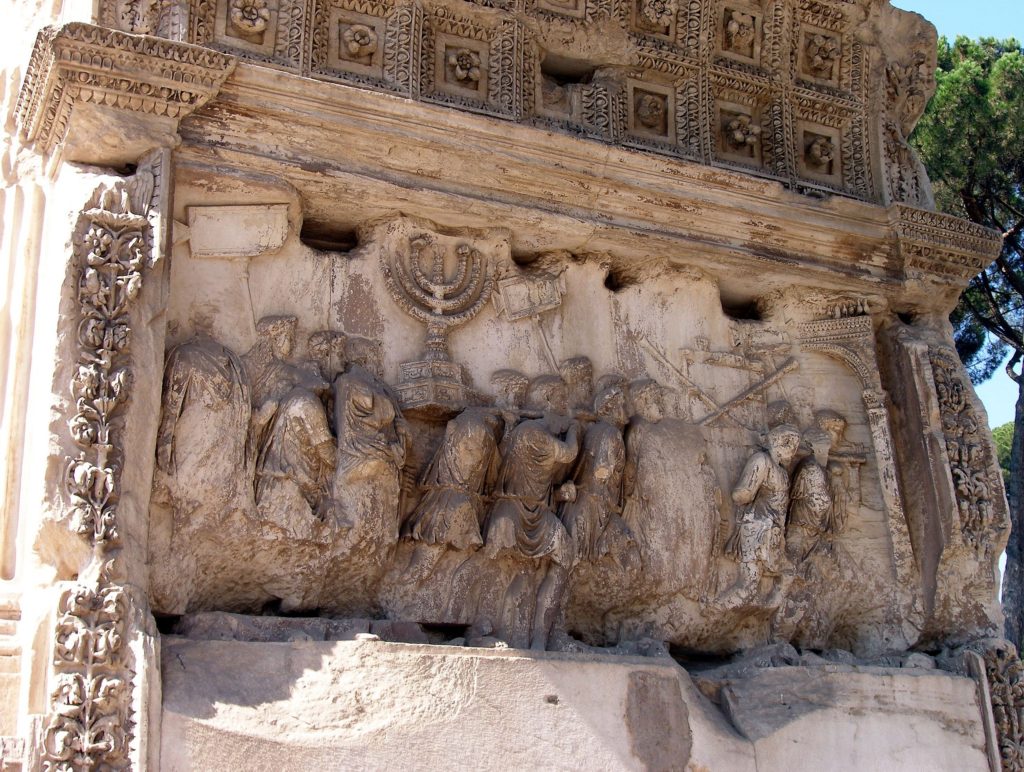
Close up of relief showing spoils from the Siege of Jerusalem
The Arch provides one of the few contemporary depictions of Temple period artifacts.[13][14] The seven-branched menorah and trumpets are clearly depicted. It became a symbol of the Jewish diaspora. In a later era, Pope Paul IV made it the place of a yearly oath of submission. According to Morton Satin, until the modern State of Israel was founded in 1948, Jews refused to walk under it due to an ancient ban placed on the monument by Rome’s Jewish authorities. The ban was formally lifted in 1997.[15] The arch was never mentioned in rabbinical sources.[16] The menorah depicted on the Arch served as the model for the menorah used on the emblem of the state of Israel.[17]
The north panel depicts Titus as triumphatorattended by various genii and lictors, who carry fasces. A helmeted Amazonian, Valour, leads the quadriga or four horsed chariot, which carries Titus. Winged Victory crowns him with a laurel wreath.[8] The juxtaposition is significant in that it is one of the first examples of divinities and humans being present in one scene together. This contrasts with the panels of the Ara Pacis, where humans and divinities are separated.[8]
The sculpture of the outer faces of the two great piers was lost when the Arch of Titus was incorporated in medieval defensive walls. The attic of the arch was originally crowned by more statuary, perhaps of a gilded chariot.[8] The main inscription used to be ornamented by letters made of perhaps silver, gold or some other metal.
The Arch of Titus measures:
15.4 meters (50 ft) in height,
13.5 meters (44 ft) in width,
4.75 meters (15.5 ft) in depth.
The inner archway is
8.3 (27 ft) meters in height,
5.36 (17.5 ft) in width.
The inscription in Roman square capitals reads:
SENATVS
POPVLVSQVE·ROMANVS
DIVO·TITO·DIVI·VESPASIANI·F(ILIO)VESPASIANO·AVGVSTO
which means:
“The Roman Senate
and People (dedicate this)
to the divine Titus Vespasianus Augustus,
son of the divine Vespasian.”
The opposite side of the Arch of Titus received new inscriptions after it was restored during the pontificate of Pope Pius VII by Giuseppe Valadier in 1821. The restoration was intentionally made in travertine to differentiate between the original and the restored portions.
The inscription reads:
INSIGNE · RELIGIONIS · ATQVE · ARTIS · MONVMENTVM
VETVSTATE · FATISCENS
PIVS · SEPTIMVS · PONTIFEX · MAX(IMVS)
NOVIS · OPERIBVS · PRISCVM · EXEMPLAR · IMITANTIBVS
FVLCIRI · SERVARIQVE · IVSSITANNO · SACRI · PRINCIPATVS · EIVS · XXIIII
which means:
(This) monument, remarkable in terms of both religion and art,
had weakened from age:
Pius the Seventh, Supreme Pontiff,
by new works on the model of the ancient exemplar
ordered it reinforced and preserved.• In the 24th year of his sacred rulership. •
Thickness of Pillars : 4 fingers (3 – 3.14 inches) (handbreadth/palm) – per Jeremiah 52:21
CIRCUMFERENCE = 3.14159265 x diameter
31.4 – 30 = 1.4 cubits (from 1 Kings 7:23)
1.4 cubits = 25.2″ :: THE SACRED CUBIT
90 Total rooms
3 stories
30 each floor
Door on lower right side that had winding staircase up to the 3rd floor
Doors
4 sided doorposts of olive wood
2 doors of cypress wood
2 leaves on each door turned the pivots
Walls and Altar built with cedar wood
Floors with cypress wood
Then all was overlaid with gold.
Stones against the house were5 cubits wide
Solomon carved cherubim, palm trees, open flowers and overlaid them with gold
Inner court was built with 3 rows of cut stone and a row of cedar beams
Chains were in the middle sanctuary, which had a 100 pomegranates on them, and he placed them on tops of pillars
10 Golden Lamp stands
10 Tables
100 Golden Bowls
Ark
CUBITS YARDS FEET INCHES length 1.5 2’3″ 27″ width 2.5 3’9″ 45″ height 1.5 2’3″ 27″
480 x 360 = 172,800
172,800 + 3(2nd day of 2nd month) 2 Ch 3 = 172,831 days
Genesis 1:1 :: Sum of the combinations :: 172,864
172,864 – 172,831 days = 33
7 years and 6 months Total = 2700 days
The same amount of time David ruled in Hebron
949 BC ::: Year 3155 ::: 1499 after flood
1499:: 239thPrime
11th year = 487th year since Exodus
487::93rd Prime
Outer Court ::(work of Hiram)
Hiram constructed the outside
Solomon constructed the inside
The course of events seems to have been as follows:
- David of Israel and 1st Hiram King of Tyre were great friends and, probably, about the same age.
- After David captured Jerusalem, his friend in Tyre sent him masons and carpenters to build an house for him.
- War had for years devastated Judea, causing the arts and manufactures to be neglected. The peaceful occupations of the builder and the artist had been abandoned for that of the warrior, and hence David had to obtain those from Tyre; which was then famous all the world over for its arts and manufactures. Time passed and age began to steal over the hardy shepherd, warrior and poet king.
- 26 years after the building of his house his friend, the 1st King of Hiram dies, and is succeeded by his son, Hiram the 2nd King of Tyre, ;
- 7 years afterwards, David himself is gathered to his fathers and Solomon, then 30 years of age, ascended the throne.
- In the fourth year of his reign Solomon began to build the Temple, with the assistance of Hiram, the 2nd king of Tyre, the successor of the 1st King of Tyre, Hiram the friend of David.
- Hiram, King of Tyre furnished Solomon with the Cedar, Fir, and Algum Trees from Lebanon and the Gold from Parvaim.
- The Sidonians hewed them and Hiram conveyed them by sea on floats to Joppa.
- The foundation of the house was prepared by Solomon’s and Hiram’s builders, and the stonesquarers of Giblites (boundary/mountain);a Phoenician city whose inhabitants were sailors and architects.
- The Stones were already prepared before being brought so no hammer, axe, or iron tool could be heard during construction.
- The Stones laid the foundation/inner court for the Temple and was completed within the first month.
- The Temple took 7.5 years to complete.

